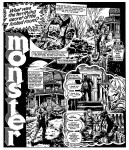 Monster, a comic strip published by Scream! from authors Alan Moore (Watchmen) and John Wagner (Judge Dredd) is coming back to store shelves this July. After being out of print since the ‘80s, the series is coming back via 2000 A.D.. The title is being printed in an 190-page graphic novel. The Guardian has the […]
Monster, a comic strip published by Scream! from authors Alan Moore (Watchmen) and John Wagner (Judge Dredd) is coming back to store shelves this July. After being out of print since the ‘80s, the series is coming back via 2000 A.D.. The title is being printed in an 190-page graphic novel. The Guardian has the […]
Viewing: Blog Posts Tagged with: 2000AD, Most Recent at Top [Help]
Results 1 - 25 of 133
Blog: PW -The Beat (Login to Add to MyJacketFlap)
JacketFlap tags: Monster, Comics, Breaking News, Publishers, 2000AD, Moore, Alan Moore, Top News, Top Comics, John Wagner, Rick Clark, Scream!, Add a tag
Blog: PW -The Beat (Login to Add to MyJacketFlap)
JacketFlap tags: Top News, 2000AD, Diamond, Add a tag
It’s not too soon to think about Free Comic Book Day 2016, which is just what publishers and Diamond are going. The annual comics holiday — held the first Saturday of May — sees 5.6 million free comics given away to customers. While the number of comics in the program has been cut in recent […]
Blog: PW -The Beat (Login to Add to MyJacketFlap)
JacketFlap tags: Interviews, History, Comics, Culture, Comic Strips, 2000AD, Alan Moore, Top News, Add a tag
Here’s the sixth part of my interview with the late Steve Moore, with more to follow. The 1st, 2nd, 3rd, 4th, and 5th parts are already online, along with some explanation of how the interview came about.
One note on the text, which is particularly relevant in this section, so worth repeating: As we went along, I would ask supplementary questions, which got inserted into the previous text. To make it clear where a question has been added in later, I’ve included little arrows for those subsidiary questions, like this: ->. Occasionally, there were further questions, which are indicated by an ever expanding length of arrow, like this –> or this —>. Hopefully this will help to understand how the interview unfolded. So…
PÓM: You were a young man in a very vibrant and modern London, at that time. Did you have any interaction with the kind of things we hear about it, like the emerging drug culture?
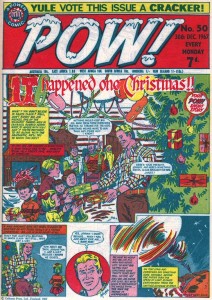 SM: Well, I had a couple of nice hippy bells [bell-bottom jeans, for those of you too young to know what he's talking about - PÓM] when I was working on Pow! (Ken Mennell was most derisive!) But in many ways I was more of a passive participant. I read things like International Times and Oz and I bought psychedelic albums by people like Pink Floyd and Jimi Hendrix, and occasionally I’d go to hip bookshops like Indica and Compendium (and, of course, Bookends was quite hip, though that was 1972, rather than the late 1960s). But I didn’t go on protest marches and I rarely went to see bands or to events like the 14 Hour Technicolor Dream at the Alexandra Palace (and I rather missed out on the ‘free love’ too, unfortunately). I listened to John Peel’s Perfumed Garden show on Radio London in the summer of 1967, and he encouraged listeners to meet up, wearing Perfumed Garden badges to identify one another. So I made myself a badge and when a meeting was announced on the radio at Greenwich Park I went off and met a few people. I’d guess there were about a dozen people there, one of whom was Phil Bevan, with whom I became quite friendly for a few years, and who also worked at Fleetway House for a while as an art assistant, shortly before I left. We produced a little booklet together for the fanzine market in 1971 called Doomlore, a rather twee fantasy story that I wrote and he illustrated, and he also contributed to the unpublished Orpheus #2. And we’d occasionally drop acid together.
SM: Well, I had a couple of nice hippy bells [bell-bottom jeans, for those of you too young to know what he's talking about - PÓM] when I was working on Pow! (Ken Mennell was most derisive!) But in many ways I was more of a passive participant. I read things like International Times and Oz and I bought psychedelic albums by people like Pink Floyd and Jimi Hendrix, and occasionally I’d go to hip bookshops like Indica and Compendium (and, of course, Bookends was quite hip, though that was 1972, rather than the late 1960s). But I didn’t go on protest marches and I rarely went to see bands or to events like the 14 Hour Technicolor Dream at the Alexandra Palace (and I rather missed out on the ‘free love’ too, unfortunately). I listened to John Peel’s Perfumed Garden show on Radio London in the summer of 1967, and he encouraged listeners to meet up, wearing Perfumed Garden badges to identify one another. So I made myself a badge and when a meeting was announced on the radio at Greenwich Park I went off and met a few people. I’d guess there were about a dozen people there, one of whom was Phil Bevan, with whom I became quite friendly for a few years, and who also worked at Fleetway House for a while as an art assistant, shortly before I left. We produced a little booklet together for the fanzine market in 1971 called Doomlore, a rather twee fantasy story that I wrote and he illustrated, and he also contributed to the unpublished Orpheus #2. And we’d occasionally drop acid together.
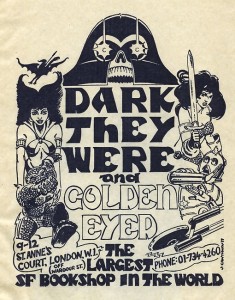 From which you’ll gather that, if I had a fairly marginal involvement with the culture, I had an amiable relationship with the drugs. I first smoked hashish in 1969 with the set of friends I mentioned that had gathered round the founding of Dark They Were and Golden Eyed and, of course, they’re absolutely right when they say it can lead you to much more addictive drugs. In my case, it was tobacco. I only started smoking cigarettes as a result of smoking dope, and that was a habit I didn’t kick until 2000.
From which you’ll gather that, if I had a fairly marginal involvement with the culture, I had an amiable relationship with the drugs. I first smoked hashish in 1969 with the set of friends I mentioned that had gathered round the founding of Dark They Were and Golden Eyed and, of course, they’re absolutely right when they say it can lead you to much more addictive drugs. In my case, it was tobacco. I only started smoking cigarettes as a result of smoking dope, and that was a habit I didn’t kick until 2000.
Hashish was something I mainly indulged in when it was easily available, as it was at Bookends and during the time I worked at and hung out at DTWAGE, especially in the final years in St. Anne’s Court, when it was delivered by motorcycle courier. Otherwise, friends would get it for me when they got theirs; I had very little contact with actual dealers. So a lot of my work in the first period of my comic career, from 1972 to the late 1980s, was written on dope; I seem to recall this was particularly the case on Warrior. These days I can’t work on it at all, but since I gave up smoking I’ve had to eat it, and that can have a tendency to just wipe out all inclination to work anyway. Especially the way I tend to overdo it.
There were psychedelics around in the late 1960s and early 1970s as well, of course, though I tended to be a bit timid about those. Where friends would say ‘I’m taking two (or three) tabs of acid!’ I’d tend to say ‘I think I’ll stick to one.’ As a result I rarely got completely blitzed, though I had some interesting experiences; but I think I liked to stay in control a bit too much (though that hasn’t stopped me, on occasion, eating so much hashish I passed out, or laughed so much I went into cataplectic fits). There were a few LSD trips, a couple with mescaline (if that was, in fact, what was in the tablet it was sold as) and rather more with psylocybin mushrooms, which are probably my favourite psychedelic, though I hardly ever indulge these days.
When things got tough at Bookends, toward the end, we resorted to amphetamines for a while, to get the work done, which isn’t at all a good idea; and, being available during the late 1970s when I was hanging out at DTWAGE, I indulged again for a little while (though never since). If someone offered me a free line of cocaine I wouldn’t say no, and I smoked opium once or twice, but it only put me to sleep and didn’t do anything. Heroin and barbiturates I stayed well away from, though, as I could see the damage they were doing to people I knew. So it’s really mainly been hashish.  I’ve tended to steer clear of modern, laboratory-made drugs, preferring stuff that occurs naturally. But I’m really not into ‘drug culture’ the way some ageing hippies are. If somebody says ‘Oh, but you must try so-and-so!’ I just say ‘no’, these days.
I’ve tended to steer clear of modern, laboratory-made drugs, preferring stuff that occurs naturally. But I’m really not into ‘drug culture’ the way some ageing hippies are. If somebody says ‘Oh, but you must try so-and-so!’ I just say ‘no’, these days.
And if you ask: ‘can drugs increase creativity?’ I’d probably say, on balance, that for me, they probably haven’t, though I know some people would have a different view; but they probably haven’t decreased it, either. I neither advocate nor oppose them. When they were there, I took them; when they weren’t, I got on without them. That’s life…
PÓM: You mentioned you thought some of the Chinese clubs might have been run by Triads. Did you have any proof of this, or indeed any contact with the Triads, as you became more immersed in Chinese culture?
SM: No, I can’t prove they were run by Triads, though I rather suspect it. The best I can say is that this is what’s known as ‘informed speculation’. But it turned out that my friend, the young kid who’d been working as a projectionist and letting me in to the movies for free, quite separately managed to get involved with the Triads, and not in a very pleasant way.
For reasons that will soon become apparent, I’m going to call him ‘Chang’, though that wasn’t his real name. Well, by the end of the 1970s, the cinema clubs were starting to close down, to be replaced by Chinatown video hire shops, which meant that I lost touch with my beloved Chinese movies until the advent of the home video market in the mid-1980s. It also meant that Chang lost his job. By then he was in his early 20s and married to a Chinese immigrant who’d illegally entered Hong Kong, and they had a baby, so without the projectionist job he then started working in a takeaway restaurant in Watford. When he was back in London, I’d occasionally meet him for lunch, often accompanied by his equally young Scottish friend ‘Peter’ (again, not his real name), who seemed nice enough. And then the lunches stopped, and we just sort of drifted apart.
Then a couple of years later, in the early 1980s, Chang suddenly turned up on my doorstep (I think on a Saturday morning), in something of a state, which I eventually realised was fear. So I got him on his own (my mother and brother were still here) and a rather complex story came out. It seemed that, like many Chinese, Chang was fond of gambling, and he told me he’d borrowed £500 from a Triad loan-shark to get himself a stake. Obviously, that was worth rather more back in those days than it would be now. I think Chang had been mainly gambling on arcade gaming-machines in Soho but, unsurprisingly, he’d lost all the money. I don’t know what the interest would have been – probably something like 10% a week – but now the Triads wanted their money back, and they meant ‘now’, not ‘soon’. So he was sleeping in his car and hoping they wouldn’t find him.
Chang, however, had a novel solution in mind, involving Peter – of whom, it seemed, I’d gained a rather mistaken impression. Instead of being the innocent young kid I thought, it turned out he was actually both gay (I hadn’t realised) and an armed robber, who sometime previously had attempted to mug a pensioner at Waterloo. Things went wrong, however, when the pensioner not only fought back, but started chasing him as well, at which point Peter turned round and shot the man in the head, leaving him in a vegetative state. He then fled to Thailand with his Thai boyfriend, and I think was about to return now that the heat had died down a bit.
So Chang’s plan was to turn Peter in for the £1500 reward that had been offered, and use the money to pay off his Triad creditor. The only problem with this plan was that the reward wouldn’t be paid out until a conviction was obtained, so he wanted to stay with me in the meantime, in the hope that the Triads wouldn’t look for him here.
I still have very mixed feelings about my reaction to this (I’m not sure it was my finest hour), but I’d had a fairly sheltered upbringing with no direct contact with the underworld, and I really didn’t want my aged mother opening the door to a bunch of armed Triad thugs if they turned up looking for Chang. Or my brother or myself, come to that. I asked Chang if there was anywhere else he could go, and he said he knew someone in Manchester (which itself was a Triad hotbed, so I’m not sure this was the best option). So I gave him a blanket and all the money I had in my wallet, which I think was about £70, and off he went. I never heard from him again, so I don’t know what happened about the plan to shop Peter to the police, or whether Chang sorted out his differences with the Triads. But I find it very difficult to think of a particularly positive ending to the story. Perhaps it’s better not to know…
So that’s as close as I got to the Triads and, frankly, even that was rather closer than I wanted to get. But I still sorta hope that Chang managed to get out of that scrape … somehow …
PÓM: What sort of amount of work were you producing at that time?
SM: I’ve a feeling things may have been a bit slack around 1975/76, and that may have been the period when for a few months I worked a couple of days a week at DTWAGE. Each year I had the annuals to carry me through from about September to February, and on average there’d be four or five books to work on. I also know I did a few projects that never saw publication – I particularly remember doing a comic-strip adaptation of Stevenson’s Treasure Island for someone (which was the first time I’d actually read the book, and I found it far more enjoyable than I’d expected), but it never appeared. That may have been around this time. And it was probably around then that I was writing the movie scripts. But work started to pick up with House of Hammer, and then at the beginning of 1977 there was 2000 AD and in 1978 Hulk Comic, followed by Dr Who and Warrior. So the end of the ’70s and the beginning of the ’80s was one of my busiest periods of comic-book writing. I never made a fortune and (as I may have said earlier), if I’d had a mortgage to pay and a family to support I would have been in some difficulty. But I had enough to buy books, which has always been my first priority!
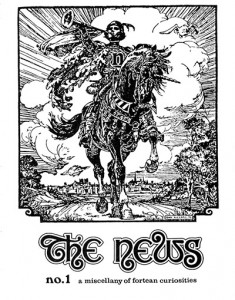 And apart from the paying work, I was writing stuff for Fortean Times as well. I had a regular oriental column around then called ‘Tales from the Yellow Emporium’ (a pun on the legendary Chinese ruler, the Yellow Emperor), and I’d write up archaeological stories, and occasionally more regular Fortean material. So I kept myself busy.
And apart from the paying work, I was writing stuff for Fortean Times as well. I had a regular oriental column around then called ‘Tales from the Yellow Emporium’ (a pun on the legendary Chinese ruler, the Yellow Emperor), and I’d write up archaeological stories, and occasionally more regular Fortean material. So I kept myself busy.
PÓM: Did you do any work for Dez Skinn while he was in charge of Marvel UK?
SM: Yes, quite a bit. Dez moved to Marvel UK shortly after HoH folded, and started Hulk Comic at the beginning of 1979. The first issue came out in March, so there would have been a bit of lead-time before then when we were working on this. Dez had the idea that we should do original material featuring Marvel heroes, but tailored for the British market, and I think this was around the time of the Hulk TV series with Lou Ferrigno. This was alongside the reprint material as well, so I think the early issues actually had two Hulk strips in each issue, one reprint, one original. I’m pretty sure I wrote at least some of the Hulk stories, though I can’t remember if I wrote all the original stories or shared them with Steve Parkhouse. The main thing I wrote for this, though, was Nick Fury, which I think ran for the first 19 issues. This was drawn by Steve Dillon, who was about 16 at the time, and it may well have been his first strip. I don’t think I actually met Steve when we were doing this. It was still the time when for the most part a writer would have no idea of who’d be drawing his script, and no contact with the artist; a situation that I think only really started to change when Warrior began, at which point I worked very closely with Steve.
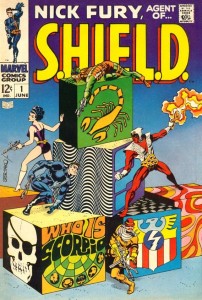 I haven’t looked at Nick Fury for many years, so I’ve no idea how good it was, but I remember really enjoying writing it. The original strip had been one of my favourites, especially when Jim Steranko was drawing it, and it was the sort of non-superhero adventure that I liked to do. Writing it was also very influential on my later work, as the ‘tough dude with smart dialogue’ that was Fury influenced my characterisation of both Abslom Daak and the straight, non-underground version of Axel Pressbutton, though obviously in both cases this got twisted up with a lot of other weird stuff that went into them too.
I haven’t looked at Nick Fury for many years, so I’ve no idea how good it was, but I remember really enjoying writing it. The original strip had been one of my favourites, especially when Jim Steranko was drawing it, and it was the sort of non-superhero adventure that I liked to do. Writing it was also very influential on my later work, as the ‘tough dude with smart dialogue’ that was Fury influenced my characterisation of both Abslom Daak and the straight, non-underground version of Axel Pressbutton, though obviously in both cases this got twisted up with a lot of other weird stuff that went into them too.
Eventually the original strips were dropped, presumably because they were less economical than the reprints. And, of course, by then we were starting work on Dr Who Weekly, the first issue of which appeared in October 1979. So I just moved from one to the other, and kept on working for Dez.
PÓM: How aware were you of what else was going on in the UK comics business at that time? Pat Mills and the like seemed in particular to be trying to push what they could get away with.
SM: I was hardly aware of anything at all except what I was working on. Since I’d gone freelance I wasn’t really reading comics for pleasure and no longer considered myself a fan, and I’d never even heard of Pat Mills before 2000 AD. I’d really kept away from IPC, once I’d dropped writing the odd Slowcoach story for Whizzer and Chips (okay, apart from Mirabelle!) as I didn’t like their editorial attitudes when it came to handling scripts, and I much preferred to work for relatively smaller companies, rather than a big corporation like IPC, with its corporate attitudes. I gather that Pat was doing some fairly progressive stuff on Action and Battle, but Battle was a war comic, which of course was revolting to me, so I wouldn’t have gone anywhere near it. And, besides, I really hadn’t envisaged working for IPC again until 2000 AD came along, which only interested me because it was an SF comic.
 PÓM: Did you end up writing for any of those new titles? I’m primarily thinking of 2000 AD here, of course.
PÓM: Did you end up writing for any of those new titles? I’m primarily thinking of 2000 AD here, of course.
SM: It was basically just 2000 AD, though before we talk about that I’d just like to briefly mention the short-lived comic Tornado as it’s a good illustration of my relationship with IPC. Tornado was a mixed action and adventure comic that started in 1979, under the editorship of Kelvin Gosnell, and only lasted 22 issues. I was already working for 2000 AD by this time, and Kelvin asked me to contribute a short strip starting in Tornado’s first issue. He may actually have asked me for a historical story, but anyway I persuaded him to take a three-issue series, which was a true story about the Japanese warrior-monk, Benkei, who lived in the 12th century and was eventually killed by his enemies. There was enough adventure in his life for me to make a decent little three-part series, but I was basically writing a historical biography of a real person, ending with his heroic death. When the comic eventually appeared I found they’d altered the ending into something much more optimistic. I haven’t got a copy to hand, but I seem to remember they’d changed it so that Benkei actually escaped his enemies and ‘became a legend’. This they’d done without consulting me, and they’d put my name on the strip, which, to anyone who knew about Benkei, would have made me look a complete idiot. I was so annoyed I never worked for Tornado again.
I can’t remember exactly how I got involved with 2000 AD. I think I must have heard about it over the grapevine from someone, and it was an SF comic so I got in touch with them, rather than them approaching me. I think at the time my only other work was House of Hammer and the annuals, so I was looking for a bit of extra work. But I never actually felt comfortable working for it, for a number of reasons. One of them was the thing I just mentioned about IPC being a large corporation, and whereas I always felt with a smaller company that I was working with the editor as a collaborator, with IPC I always felt I was working for them, as a hired hand. Successive editors of 2000 AD have always given me the impression that they thought it was an enormous privilege to work for it, and that I should be grateful – presumably because they always had lots of other people wanting to get in on the act. The only editor who I actually felt made me welcome was Andy Diggle, when I returned to work for the title in 2000. I also used to feel that the editors and contributors formed a sort of clique that went to conventions and on signing tours together, and from what I hear a lot of them are heavy drinkers. As I’m not a drinker and can think of nothing more ghastly than spending an evening with a bunch of drunks talking about comics, I never really penetrated the clique, and always felt something of an outsider. And lastly, of course, I don’t actually like the comic that much.
I always thought Judge Dredd was utterly loathsome (though I did write one short strip for an annual). I appreciate that it was often beautifully drawn and that John Wagner’s a good writer, and I’m also told that it’s supposed to be satirical on occasion, but it espouses execution without trial and is basically about a personality-free fascist who I find about as entertaining as that hilarious Mister Hitler. 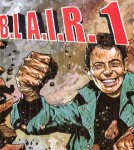 Then there are the thinly disguised IPC war stories like Rogue Trooper, and B.L.A.I.R.1, the side-splitting super-adventures of that notorious war-criminal Tony Blair. What could they have been thinking of? Even when I was working for 2000 AD, I couldn’t actually bring myself to read the rest of the comic. And I absolutely hated Tharg, which I thought was utterly stupid and childish, and brought down the tone of what I was given to believe was supposed to be aspiring toward a slightly more adult comic. I still feel the same way – and of course, they’re still continuing with the same dim-witted puerility, even though I gather that the average age of a 2000 AD reader these days is somewhere between 30 and 40. But if they’ll still put up with something as irritating as Tharg, I’m not sure exactly how the term ‘adult’ applies here.
Then there are the thinly disguised IPC war stories like Rogue Trooper, and B.L.A.I.R.1, the side-splitting super-adventures of that notorious war-criminal Tony Blair. What could they have been thinking of? Even when I was working for 2000 AD, I couldn’t actually bring myself to read the rest of the comic. And I absolutely hated Tharg, which I thought was utterly stupid and childish, and brought down the tone of what I was given to believe was supposed to be aspiring toward a slightly more adult comic. I still feel the same way – and of course, they’re still continuing with the same dim-witted puerility, even though I gather that the average age of a 2000 AD reader these days is somewhere between 30 and 40. But if they’ll still put up with something as irritating as Tharg, I’m not sure exactly how the term ‘adult’ applies here.
But work was work and, besides, at the beginning I didn’t really know what direction the comic would be going. I was well-established enough by that time for them to offer me the second story-arc on the revamped Dan Dare, which I think ran from about issue 12 to 20, or something like that, and was drawn by Bellardinelli, an artist who didn’t appeal to me much at all. All I can remember about the story is that the villain had two heads, which argued with each other. I didn’t much like the new Dan Dare, and maybe it showed, because they didn’t offer me another series on it.
 So after that, they asked me to write short stories as filler material, which is what turned out to be the Future Shock series (though the fact that they were then called ‘Tharg’s Future Shocks’ and were given dumb introductions pissed me off – as did being described as a ‘script robot’). Essentially I based the format on the old EC twist-ending SF stories and they’ve been doing the same thing ever since. I think I wrote the first dozen or so and, interestingly, the first few could be written to different page-lengths, just depending on how the story came out. I seem to remember writing one that was only two pages long, though later they settled into a more standard five-page format. I think they then began bringing in other writers, though I wrote a few more. And that was pretty much my first period of involvement with 2000 AD. I then got enough work with Marvel UK, and was happy to leave 2000 AD behind.
So after that, they asked me to write short stories as filler material, which is what turned out to be the Future Shock series (though the fact that they were then called ‘Tharg’s Future Shocks’ and were given dumb introductions pissed me off – as did being described as a ‘script robot’). Essentially I based the format on the old EC twist-ending SF stories and they’ve been doing the same thing ever since. I think I wrote the first dozen or so and, interestingly, the first few could be written to different page-lengths, just depending on how the story came out. I seem to remember writing one that was only two pages long, though later they settled into a more standard five-page format. I think they then began bringing in other writers, though I wrote a few more. And that was pretty much my first period of involvement with 2000 AD. I then got enough work with Marvel UK, and was happy to leave 2000 AD behind.
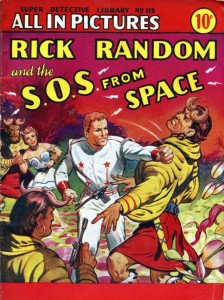 I returned in the early 1980s (when the editor was Steve McManus, who I found smug, arrogant and unsympathetic) to write some more Future Shocks and, of course, by then Alan Moore was writing them too, so we used to have a bit of a private competition to see just how far we could push the ideas and still get away with it. And at that time I also got the chance to write a revived series of Rick Random, a strip I’d loved back in the 1950s Super Detective Library, and with Ron Turner, the original artist. Apart from beefing the action up a little for a 2000 AD audience, I tried to write it fairly straight … more a tribute than an updated revision … and I think it was about six episodes long. I was really pleased with it until the last episode appeared in print, at which point it turned out that, for some reason I never discovered, Turner hadn’t finished the strip, and (of course, without informing me) they’d given the last episode to Carlos Ezquerra, an artist I hated anyway, and one who really couldn’t have been further away in style from Turner, and who made no attempt to emulate what Turner had already done. If they’d given the episode to someone like Dave Gibbons I would have understood it, and it would probably have been a reasonably close match – but they gave it to Ezquerra. So, you won’t be surprised to hear that after that I didn’t work for 2000 AD again for another fifteen years or so.
I returned in the early 1980s (when the editor was Steve McManus, who I found smug, arrogant and unsympathetic) to write some more Future Shocks and, of course, by then Alan Moore was writing them too, so we used to have a bit of a private competition to see just how far we could push the ideas and still get away with it. And at that time I also got the chance to write a revived series of Rick Random, a strip I’d loved back in the 1950s Super Detective Library, and with Ron Turner, the original artist. Apart from beefing the action up a little for a 2000 AD audience, I tried to write it fairly straight … more a tribute than an updated revision … and I think it was about six episodes long. I was really pleased with it until the last episode appeared in print, at which point it turned out that, for some reason I never discovered, Turner hadn’t finished the strip, and (of course, without informing me) they’d given the last episode to Carlos Ezquerra, an artist I hated anyway, and one who really couldn’t have been further away in style from Turner, and who made no attempt to emulate what Turner had already done. If they’d given the episode to someone like Dave Gibbons I would have understood it, and it would probably have been a reasonably close match – but they gave it to Ezquerra. So, you won’t be surprised to hear that after that I didn’t work for 2000 AD again for another fifteen years or so.
PÓM: I know that yourself and Alan Moore are friends, and have worked together on many things over the years. Do you remember how the pair of you first got in touch with one another, and when you first met?
SM: This is a bit vague, but Alan and I spoke about this recently and I think we’ve got it sorted out. Before organising the first UK Comic Convention, Phil Clarke put out a sales list called The Comic Fan (this is to be distinguished from The Comic Fan Special, which was the bulletin of the Convention), and I printed the lists off for him on my duplicator. In the second issue, as well as advertising Ka-Pow #1, there was an advert from me, because, being besotted with the TV Avengers at the time, I was looking for a novelisation called Dead or Alive. Alan saw those ads, wrote to me, and so the correspondence started.
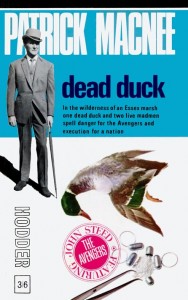 Unfortunately, that issue of The Comic Fan carries no date, but as Ka-Pow #1 had already been published, it was some time after July 1967. The odd thing about this, though, is that Dead or Alive is a book that never existed. At the time, Hodder published a couple of Avengers novels, credited to Patrick MacNee but ghosted by Peter Leslie, called Deadline and Dead Duck. Dead or Alive was advertised as the third in the series, which was why I wanted it, but if it was ever written it never appeared. So the whole friendship is basically rooted in a quest for a non-existent, chimaerical book … which is a motif that’s turned up occasionally in the work of one or other of us, in mine as recently as Somnium. It’s not a bad symbol for writers, too, as their job is to bring non-existent books into existence, by writing them. But perhaps more interestingly, in view of our more recent notions about Idea Space, we were brought together by the idea of a text, rather than a real one. Attribute whatever significance you wish to that. Maybe it was just the universe having a laugh.
Unfortunately, that issue of The Comic Fan carries no date, but as Ka-Pow #1 had already been published, it was some time after July 1967. The odd thing about this, though, is that Dead or Alive is a book that never existed. At the time, Hodder published a couple of Avengers novels, credited to Patrick MacNee but ghosted by Peter Leslie, called Deadline and Dead Duck. Dead or Alive was advertised as the third in the series, which was why I wanted it, but if it was ever written it never appeared. So the whole friendship is basically rooted in a quest for a non-existent, chimaerical book … which is a motif that’s turned up occasionally in the work of one or other of us, in mine as recently as Somnium. It’s not a bad symbol for writers, too, as their job is to bring non-existent books into existence, by writing them. But perhaps more interestingly, in view of our more recent notions about Idea Space, we were brought together by the idea of a text, rather than a real one. Attribute whatever significance you wish to that. Maybe it was just the universe having a laugh.
After that, Alan seems to think that we first met face-to-face at the second Con in 1969. I’ve a notion, though, that we first met on a day-trip he made to London with his parents. I met them in town (where they presumably got the chance to check me out and see that I was, in fact, at least basically human) and then brought Alan back to my house for the afternoon before returning him, apparently undamaged, to the loving arms of his family. But exactly when that trip was (i.e., either before or after the 1969 Con) may be open to dispute. I think it was before. Actually, considering how important that first contact turned out to be for both our lives, it’s surprising how fuzzy the whole thing is. Maybe the Martians have tampered with our memories. Or, more likely, it’s the drugs.
Either way, the tradition we’ve always maintained is that we’ve known each other since I was 18 and he was 14. Going by our respective birthdays, that would mean we’d have to have first got in touch by letter sometime between November 1967 and June 1968, which seems to fit with his being a non-attending member of the 1968 Con. Whenever it was, I think one of the things that drew us together initially was the coincidence of our surnames, absurd though that may seem. Of course, in the decades since I’ve seen myself referred to as ‘no relation’ so many times I rather feel they’ll put it on my tombstone, and it was with considerable glee that when we got to preparing the back-flap biographies of Somnium I was able to describe him as ‘Alan Moore (no relation)’!
Anyway, Alan used to send me entertaining letters decorated with little drawings of ‘The Avenging Hunchback’ (sole line of dialogue: ‘Glerk!’) and before too long we were seeing each other quite frequently. And taking drugs together, of course. Apparently, Alan decided that if I was smoking dope it must be okay for him to do so too (I don’t think his mum ever forgave me, especially after he was expelled from school).
->PÓM: Have you kept any of those letters? And, if so, how likely is it you can scan them for the rest of the world to see?
 SM: Yes, I’ve kept Alan’s letters, but obviously they have to remain private. There’s no way I’m going to embarrass him by publishing his teenage correspondence. But I’ve scanned one of the sketches of the Avenging Hunchback …
SM: Yes, I’ve kept Alan’s letters, but obviously they have to remain private. There’s no way I’m going to embarrass him by publishing his teenage correspondence. But I’ve scanned one of the sketches of the Avenging Hunchback …
PÓM: I have this romantic scenario in my head where Alan is the wild one, always leading you astray, whilst you are the quiet one, being dragged into all sorts of wild scrapes by your friend. But this is really entirely wrong, isn’t it, as regards comics, drugs, and magic? You are quite literally the man who led Alan Moore astray.
SM: Well, I’d like to portray myself as an evil Svengali who took one look at Alan and realised that here was a striking-looking but malleable individual who I could get years of pleasure destroying an inch at a time, but it wasn’t really like that … even if he has said publicly that I was the man who ruined his life! I just wander into these things like writing comics, smoking dope, practicing magic and resigning on points of principle, and the next thing I know Alan’s decided that as I haven’t actually died as a result, he’ll do the same … only he does it much larger. It’s not my fault, honest! Mind you, he doesn’t always follow my lead. I’ve never got him hooked on China or classical music, in the same way that I’ve never really shared his interest in science or stand-up comedy. We just have areas of interest that overlap … and enormous mutual respect in areas where they don’t. And even where they don’t, there’s still a bit of influence going back and forth.<-
 Alan swiftly got involved with the Northampton Arts Lab, and their poetry magazine, Embryo (and its variously-named sequels). That was another attraction for me: I’ve always chosen my closest friends (at least the male ones) among people who were actually doing things, rather than talking about doing things, and that creative bond has remained central to our friendship ever since. So I submitted a couple of poems too (don’t ask me about the quality!), which they kindly printed, and that rather set the pattern. If one of us was working on a project where we could offer an opening to the other, we did, and it’s been pretty much like that ever since.
Alan swiftly got involved with the Northampton Arts Lab, and their poetry magazine, Embryo (and its variously-named sequels). That was another attraction for me: I’ve always chosen my closest friends (at least the male ones) among people who were actually doing things, rather than talking about doing things, and that creative bond has remained central to our friendship ever since. So I submitted a couple of poems too (don’t ask me about the quality!), which they kindly printed, and that rather set the pattern. If one of us was working on a project where we could offer an opening to the other, we did, and it’s been pretty much like that ever since.
There was a time in the mid-1970s when we didn’t see each other quite so often (perhaps twice a year) mainly, I think, because Alan was busy getting married, having kids, holding down a ‘proper job’, etc. And then one day he showed up and showed me a drawing he’d done (I’ve a feeling it may have been some sort of fantasy scene with a sailing ship) and told me he wanted to get back into drawing again. And that really kicked off the second phase of our friendship, which has lasted to this day.
->PÓM: Probably a colossally stupid question, but what was Alan Moore like? What were your first impressions of him, do you remember? What appealed to you about him?
SM: You have to remember that our friendship was first established by letter, and the ones he wrote were always entertaining, funny and a bit mad. When I actually met him he was still very young, with a thick mop of hair that hadn’t yet grown long, no beard and a slightly chubby face. And he was fun. He had a great sense of humour, he was affable, honest, generous, straightforward, interesting and interested in everything, and far more sociable than I ever was. We just took to each other and haven’t been able to get rid of each other ever since.<-
PÓM: Comics legend has it that you taught Alan how to write a comic script. Do you remember this, and what advice you gave him?
SM: It’s a story that Alan has very kindly promoted himself, as well, though I’m not sure what I did really justifies it. As I’m sure you know, at the start of his career in the late 1970s Alan saw himself more as a cartoonist, and was quite capable of writing his own stories when he was just presenting a finished page of artwork. But when he decided to write serious strips for other artists to draw (and editors to read), he wanted a little advice on how to present things. So I basically just showed him some of my scripts, and how they were laid out, etc., which was very much in the British professional tradition of the ‘full script’, as I’d picked it up from people like Ken Mennell and Tom Tully, with several lines of description for each frame (I still think of the pictures in terms of the British ‘frame’, rather than the American ‘panel’).
And he sent me his first couple of scripts to look at, on which I scribbled a few comments (not with the blue pencil that editors usually used, but with a red pen so I looked far more outraged!) … mainly about things like the usual beginner’s mistakes of using too many words … and that was about it. All the rest of it was Alan’s talent. And I should, perhaps, point out that a couple of other people later asked me ‘how to write a comic-strip’; but none of them actually ‘got it’ in the same way that Alan did.
Having said that much, though, I have to add that I’ve also learned an awful lot about technique from Alan over the years. Of course, back then we were writing very basic scripts, and such things as the immensely long frame description was something he developed on his own. Later, especially in my ‘second period’ in comics after 2000, I also wrote pretty long descriptions, and that’s an example of the reverse influence. I think we really started to get interested in technical discussions about the time of Warrior, and from there it just went on. Even when I’d left the comics field for a few years in the 1990s to write and edit non-fiction, we’d still spend weekends together talking about writing technique, in various media. Mind you, Alan was always more interested in technique than I was; I tended to have a more instinctive approach, which has also been the case with things like magic. I think it’s just a basic difference in temperament.
As for why Alan reversed the usual format where frame descriptions were written in lower case and dialogue in upper case, to write his descriptions in upper and his dialogue in lower, I’ve really got no idea. I tend to look at things like that and think ‘Oh, it’s just Alan …’
PÓM: You got him some of his earliest work, like the stories he did in Marvel UK’s Dr Who comics, I believe?
SM: Obviously, Alan got the vast proportion of his early work on his own. For example, Sounds and 2000 AD he approached entirely by himself. As for Dr Who, which was a little later, that came about because I was switching from the back-up stories to the lead strip, so a new writer was needed for the back-ups. I think by then Alan had made a few sales and wasn’t a complete beginner, so I felt confident enough to recommend him as a replacement. There wasn’t anything special about this. It was just the sort of thing you’d do for a friend, and it certainly didn’t take any work away from me, so everybody won out. I don’t really remember anything else, script-wise, in the very early days. There may have been one or two other things, but my attitude was basically just that if I couldn’t or didn’t want to handle anything, Alan might as well be offered it.
Before that, though, Alan was still thinking of a cartoonist’s career, and what he mainly wanted was exposure, so he was quite prepared to do stuff for free. Steve Burgess, one of the editors of Dark Star (a magazine about West Coast rock music), worked at DTWAGE, so I knew him quite well; and they occasionally ran one-page underground strips, so I made the connection for Alan. I put him forward for some cartoons for the BJ and the Bear Annual, and I think I suggested him for a spread in the Frantic Winter Special that Marvel did in 1979. The last two, he actually got paid for!
PÓM: Just to clarify on the reference to the BJ and the Bear Annual, is it that Alan only drew the cartoons, to accompany your text? Currently, his bibliographies have his as doing both, for want of clearer information. So you’ll be doing the world of Moore scholarship in general a service by clarifying this! [It's all here, if you're interested - PÓM]
 SM: This was a feature called ‘C.B.? – That’s a Big Ten-Four!’ This was a glossary of C.B. radio slang, and I’m afraid I’ve got no idea who wrote it, but it certainly wasn’t me. Looking at the text, it doesn’t really look like Alan either, so my guess would be that it was an anonymous feature-writer working for Grandreams. Alan provided four cartoons that, printed large, stretched a very slim feature to four pages. It appeared in the BJ and the Bear Annual for 1981, and so the artwork would probably have been drawn in the winter of 1980/1981. The feature was reprinted wholesale in The Dukes of Hazzard Annual for 1982.
SM: This was a feature called ‘C.B.? – That’s a Big Ten-Four!’ This was a glossary of C.B. radio slang, and I’m afraid I’ve got no idea who wrote it, but it certainly wasn’t me. Looking at the text, it doesn’t really look like Alan either, so my guess would be that it was an anonymous feature-writer working for Grandreams. Alan provided four cartoons that, printed large, stretched a very slim feature to four pages. It appeared in the BJ and the Bear Annual for 1981, and so the artwork would probably have been drawn in the winter of 1980/1981. The feature was reprinted wholesale in The Dukes of Hazzard Annual for 1982.
PÓM: You worked together on a few strips, starting with Three Eyes McGurk and his Death Planet Commandos. How did that come about?
SM: Actually, the first thing we worked on together was a half-page strip called ‘Talcum Power’ (not ‘Powder’, as it seems to be referred to occasionally), for Dark Star #21 (July 1979). Alan had produced a full page ‘Avenging Hunchback’ strip for #19, which was pretty much a parody of the Superman origin story, and also drawn a second instalment for #20, but the artwork was stolen before it could be printed. So as a replacement for that he then did a half-page ‘Kultural Krime Komix’ in which he committed suicide over the theft, and that was pretty much the end of the Hunchback.
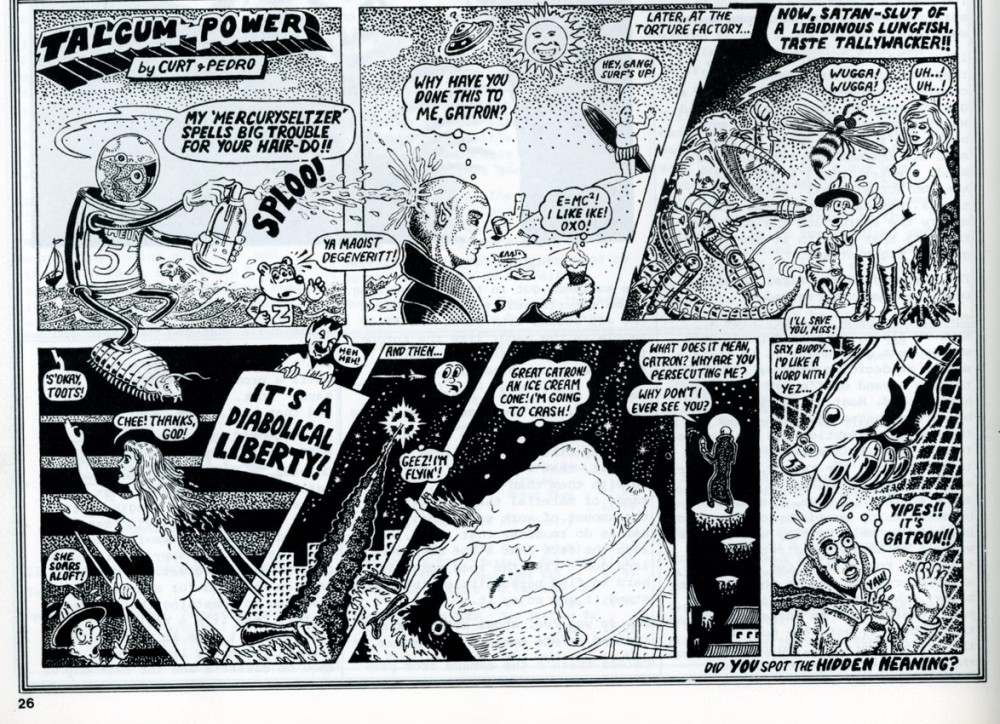 ‘Talcum Power’ was basically a jam session, constructed one stoned weekend when Alan was visiting. We ‘wrote’ as we went along, and then we pencilled bits and pieces alternately, handing the artwork back and forth (along with the joints), though Alan plainly did more of the drawing and filled out the backgrounds in most of the frames. And after he’d gone I inked and lettered the whole thing. We concluded with a tag-line saying ‘Did you spot the hidden meaning?’ to cover up the fact that it plainly didn’t mean anything at all … it was just two hippies out of their minds on drugs having a good time … but for some reason that quite escapes me now, Dark Star liked it enough to publish it. It went under the by-line ‘by Curt & Pedro’ which, as the name hadn’t gone on my ‘Bangkok sex’ article, was the first time, I think, that the Pedro Henry pseudonym appeared in print.
‘Talcum Power’ was basically a jam session, constructed one stoned weekend when Alan was visiting. We ‘wrote’ as we went along, and then we pencilled bits and pieces alternately, handing the artwork back and forth (along with the joints), though Alan plainly did more of the drawing and filled out the backgrounds in most of the frames. And after he’d gone I inked and lettered the whole thing. We concluded with a tag-line saying ‘Did you spot the hidden meaning?’ to cover up the fact that it plainly didn’t mean anything at all … it was just two hippies out of their minds on drugs having a good time … but for some reason that quite escapes me now, Dark Star liked it enough to publish it. It went under the by-line ‘by Curt & Pedro’ which, as the name hadn’t gone on my ‘Bangkok sex’ article, was the first time, I think, that the Pedro Henry pseudonym appeared in print.
Just as an aside, at around this time Alan was also drawing ‘St. Pancras Panda’ for the Oxford underground magazine, The Backstreet Bugle, and I did actually draw (all on my own!) a half-page silent strip for them called ‘Foobl’, in which an ancient city is attacked by a biplane (again, the meaning probably wasn’t apparent). That appeared in Bugle #30, August 1979, again as by ‘Pedro’. Later, in the first episode of ‘Abslom Daak: Dalek-Killer’ for Dr Who, I included a passing reference to a character called ‘C. Henry Foobl’ (derived from Curt Vile, Pedro Henry and Foobl), which was pretty much the sort of in-joke we used to indulge in back then … and later Alan actually used the character in ‘The Stars my Degradation’.
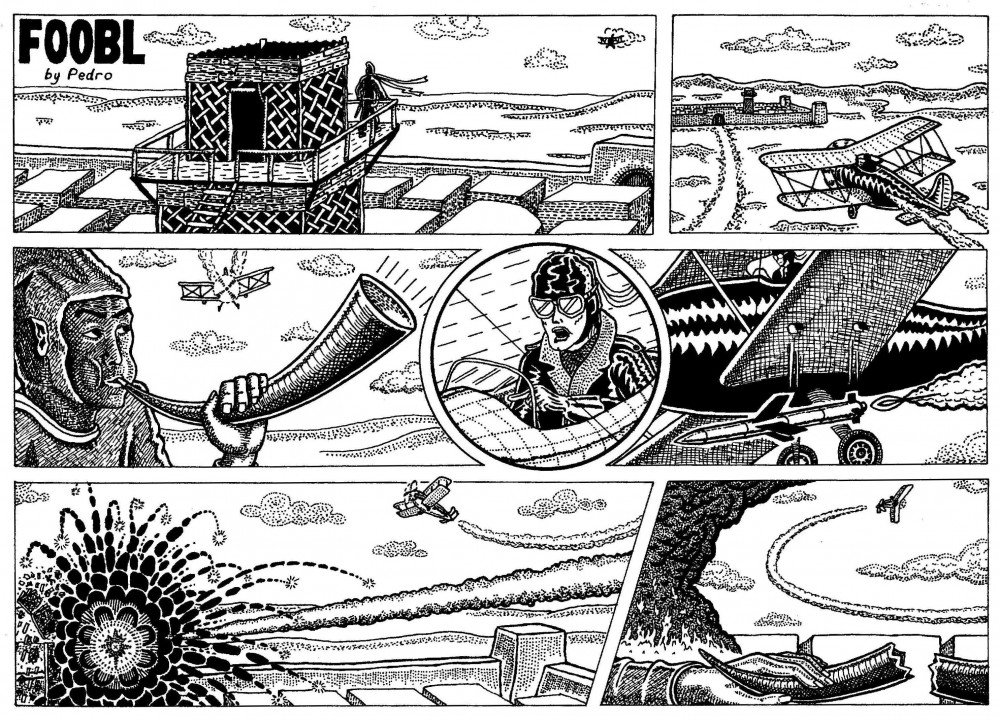 Anyway, Alan liked my inks on ‘Talcum Power’, and then asked me to write a series for him, which turned out to be ‘Three-Eyes McGurk and his Death-Planet Commandos’, which we did as by Curt Vile and Pedro Henry. We ended up with Alan pencilling while I wrote, inked and lettered, and the four episodes appeared in Dark Star #22-#25 (Dec 1979 – Jan 1981). It took absolutely ages to produce … more than a year, though obviously we had professional work to do at the same time … and Alan, trying to be helpful, produced what was virtually finished pencil artwork, including every dot of the stippling, and as the episodes progressed it just got more and more minutely detailed. While most comic-book pages are drawn ‘half up’ (i.e., half as big again as the reproduction size) or ‘twice up’, we were actually producing this ‘a fifth up’ (Alan had somehow got the completely mistaken notion that this was the ‘right’ size for comics), which meant I ended up inking most of it with a rapidograph nib 0.1mm wide. Later, when I showed the printed copies to Gilbert Shelton, who was interested in reprinting ‘McGurk’ in Rip-Off Comix #8, he guessed the originals must be huge … twice up or more … and seemed completely bewildered when I told him the actual size. Alan and I were both thrilled to be in Rip-Off (a real American underground!) and I think we actually got reprint fees of about $20 a page for it. With Dark Star, of course, we got nothing at all, but that had always been the deal from the start. Many years later, while browsing the web, I discovered that someone had actually liked the strip enough that they’d called their band the ‘Death-Planet Commandos’, though what sort of music they played I’m not sure. It would have been quite nice to know …
Anyway, Alan liked my inks on ‘Talcum Power’, and then asked me to write a series for him, which turned out to be ‘Three-Eyes McGurk and his Death-Planet Commandos’, which we did as by Curt Vile and Pedro Henry. We ended up with Alan pencilling while I wrote, inked and lettered, and the four episodes appeared in Dark Star #22-#25 (Dec 1979 – Jan 1981). It took absolutely ages to produce … more than a year, though obviously we had professional work to do at the same time … and Alan, trying to be helpful, produced what was virtually finished pencil artwork, including every dot of the stippling, and as the episodes progressed it just got more and more minutely detailed. While most comic-book pages are drawn ‘half up’ (i.e., half as big again as the reproduction size) or ‘twice up’, we were actually producing this ‘a fifth up’ (Alan had somehow got the completely mistaken notion that this was the ‘right’ size for comics), which meant I ended up inking most of it with a rapidograph nib 0.1mm wide. Later, when I showed the printed copies to Gilbert Shelton, who was interested in reprinting ‘McGurk’ in Rip-Off Comix #8, he guessed the originals must be huge … twice up or more … and seemed completely bewildered when I told him the actual size. Alan and I were both thrilled to be in Rip-Off (a real American underground!) and I think we actually got reprint fees of about $20 a page for it. With Dark Star, of course, we got nothing at all, but that had always been the deal from the start. Many years later, while browsing the web, I discovered that someone had actually liked the strip enough that they’d called their band the ‘Death-Planet Commandos’, though what sort of music they played I’m not sure. It would have been quite nice to know …
 One of the reasons Alan wanted me to script for him was that it would be a challenge, in that he’d have to draw stuff at somebody else’s bidding, rather than just taking the easy option of writing stuff for himself that he knew he could draw. I think he was a bit taken aback when I asked him to draw the Numinous Paddlesteamer, though he responded magnificently. Of course, I’d made a rod for my own back, in that I then had to ink the damned thing! We had a lot of fun: I just let myself off the hook and decided to be as mad as possible, and that drew from Alan probably his best pencils to date. But there was so much work going into everything that by the fourth episode he was sending me the pencils a quarter of a page at a time, so I could be inking while he was pencilling the next quarter, before taping together the four sections of the page. But even so I think we only just managed to get the last episode in on time.
One of the reasons Alan wanted me to script for him was that it would be a challenge, in that he’d have to draw stuff at somebody else’s bidding, rather than just taking the easy option of writing stuff for himself that he knew he could draw. I think he was a bit taken aback when I asked him to draw the Numinous Paddlesteamer, though he responded magnificently. Of course, I’d made a rod for my own back, in that I then had to ink the damned thing! We had a lot of fun: I just let myself off the hook and decided to be as mad as possible, and that drew from Alan probably his best pencils to date. But there was so much work going into everything that by the fourth episode he was sending me the pencils a quarter of a page at a time, so I could be inking while he was pencilling the next quarter, before taping together the four sections of the page. But even so I think we only just managed to get the last episode in on time.
‘McGurk’ saw the first appearance of Pressbutton, a character I’d first come up with in late 1977, and I still actually have the original notebook in which he was first scribbled down:
Character called ‘Press-button’ – he caught Vegan Green Rot years ago, and his body had to be rebuilt from the feet up to above his hips – at the same time they built a button into his chest which, when pressed, give [sic] direct electrical stimulation of the pleasure centres of his brain.
Thus he chats up broads (in bars): “Wanna press my button, honey?”
Thus he is shot to death ‘right on the button’ and dies a happy man – his chest shattered & a hideous grin on his face.
And his companions:
‘Three-Eyes McGurk’
‘Lonesome Henry, the Human Bomb’
 So, as you see, the plot for ‘McGurk’ is pretty much there from the start, apart from Pressbutton’s cleaver-arm, which evolved in the scripting. Incidentally in the very first frame he appeared in, Alan drew the cleaver on the wrong arm! At the time, though, I just thought ‘There’s no way I’m going to sell a character who has orgasms to IPC or Marvel’ (at least not in 1977) so the idea just got put aside, and it was only when I thought I could do it as an underground strip that I dusted it off. It should also be plain from this that Pressbutton was created before the Abslom Daak character I did for Dr Who. Some people seem to have got the impression that the ‘straight’ version of Axel I did in ‘Laser-Eraser & Pressbutton’, for Warrior, was somehow a ‘replacement’ for Daak, when I wasn’t writing that any more; actually it was quite the reverse … Daak was what I wrote because I couldn’t do a straight version of Pressbutton.
So, as you see, the plot for ‘McGurk’ is pretty much there from the start, apart from Pressbutton’s cleaver-arm, which evolved in the scripting. Incidentally in the very first frame he appeared in, Alan drew the cleaver on the wrong arm! At the time, though, I just thought ‘There’s no way I’m going to sell a character who has orgasms to IPC or Marvel’ (at least not in 1977) so the idea just got put aside, and it was only when I thought I could do it as an underground strip that I dusted it off. It should also be plain from this that Pressbutton was created before the Abslom Daak character I did for Dr Who. Some people seem to have got the impression that the ‘straight’ version of Axel I did in ‘Laser-Eraser & Pressbutton’, for Warrior, was somehow a ‘replacement’ for Daak, when I wasn’t writing that any more; actually it was quite the reverse … Daak was what I wrote because I couldn’t do a straight version of Pressbutton.
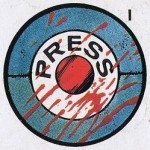 Of course, following my original idea, I had actually had Pressbutton shot ‘right on the button’ at the end of ‘McGurk’ and that, I thought, was that.
Of course, following my original idea, I had actually had Pressbutton shot ‘right on the button’ at the end of ‘McGurk’ and that, I thought, was that.
PÓM: I know Pressbutton turned up in Alan’s The Stars my Degradation strip in Sounds, which you took over writing for him a bit over halfway through its run. What I don’t remember is if he appeared before or after you were writing. So, can you set me straight, and tell me how you ended up taking over the writing of the strip?
SM: What happened was that by the summer of 1980, Alan was winding down his Roscoe Moscow strip, and decided he was going to do The Stars my Degradation, a story pretty much set in the same world as Three-Eyes McGurk (so I guess he must have enjoyed his stint on that … we were actually still drawing McGurk at the time). This sounded good to me, and then a couple of weeks later he phoned me up and asked if he could use Pressbutton in the strip. Well, I wasn’t envisaging using Pressbutton again (he was dead, after all, and I didn’t imagine I’d do any more underground strips) so I said of course he could, and he could use McGurk and any of the other material that he wanted as well. This obviously meant that the Stars material was placed earlier in Pressbutton’s life, and when we eventually did the ‘straight’ version in Warrior, that was set earlier still … so he kind of lived his life backwards. Pressbutton first appeared in the fifth instalment of Stars, and it was Alan who gave him the forename ‘Axel’ … I’d never even thought about a forename for him before that.
 There were 100 episodes of Stars and a couple of Christmas specials, before it concluded in early 1983, by which time Alan was very busy with a lot of other stuff and was struggling to find time for it. So he asked me write the last third of the series (my first episode was 62), which I was more than happy to do (I was also writing Laser-Eraser & Pressbutton for Warrior by then, so there’s an awful lot of overlapping going on here). I think Alan was getting £45 a week for writing and drawing it, and he offered me £10 for the script, so I said sure and started scripting them in batches of four or five episodes each.
There were 100 episodes of Stars and a couple of Christmas specials, before it concluded in early 1983, by which time Alan was very busy with a lot of other stuff and was struggling to find time for it. So he asked me write the last third of the series (my first episode was 62), which I was more than happy to do (I was also writing Laser-Eraser & Pressbutton for Warrior by then, so there’s an awful lot of overlapping going on here). I think Alan was getting £45 a week for writing and drawing it, and he offered me £10 for the script, so I said sure and started scripting them in batches of four or five episodes each.
->PÓM: I note that you’re also doing this interview in sets of questions, rather than one question at a time. So, is this the way you like to work, doing things in lots, rather than a piece at a time?
SM: Umm … I’m making this up as I go along, Pádraig! I’ll do it any way it comes!<-
SM: Alan had given me a very rough idea of where he imagined the story-arc going, which was pretty much a ‘back-of-an-envelope’ size synopsis, and after that I just let myself loose and tried to make it as crazy as possible. One of the things Alan had been doing with earlier episodes of the strip was parodying things like The X-Men … but I’m really not interested in parody, so I wanted to make it more of a comedy-adventure in the style of McGurk. And once again, I was challenging Alan to draw all kinds of weird shit, like rubber Episcopalians and battles between newts and Amazons and, of course, the Immolato Tomato … so I was having lots and lots of fun and Alan was probably starting to think this was a really bad idea. And we were trying to get away with as much as we could, of course, which meant the strip was frequently censored, sometimes quite crudely, with whole frames deleted, which we weren’t very pleased about.
->PÓM: What sort of things were they censoring the strips for? I’d have though that the editorial imperatives at Sounds at that time would have been quite relaxed.
SM: We just had too much sexual content for them. Alan had something of a tendency to draw penises everywhere, which usually ended up with ‘censored’ labels stuck over them, and they were obviously less interested in showing acts of sexual congress than we were. There was one occasion where Alan had decided to render the episode in pencil and they simply rubbed out a scene they didn’t like. I should point out that this had been going on before I started writing the strip as well, but I admit it got worse when I took over … but when the story moved to ‘Gomorrah’s World’, on the planet Depravity, what can one expect?<-
SM: Sounds also managed to lose one entire episode, though as this was only about Pressbutton and Harry the Hooper practising before their final showdown, probably no one noticed … except me, and I still had the script, of course.
->PÓM: Are we likely to ever see the script for that episode that Sounds lost? And is there any chance Alan could be talked into drawing it?
SM: I’ve scanned the script, and also the full script for an episode where they deleted a couple of frames entirely. The reason the scans start part way down the page is because I was writing these in batches, rather than starting a new script on a new page. We’ve no objection to these scripts being put online, but I think I can say that the chances of Alan drawing the missing script are pretty close to absolute zero.<-
[Sorry for the quality of these, folks, but this as good as I have them, I’m afraid.]
PÓM: But you were just scripting now, rather than contributing to the art?
SM: The only other art involvement I had was with the special ‘Christmas on Depravity’ story that we did in December 1981, which was just before I took over scripting the strip. The script was mainly by Alan, though we’d discussed the story when he’d been down to visit previously, and there are one or two of my gags in there. It was also the one that ‘reunited’ Axel and Mysta Mystralis, even though they hadn’t actually appeared in Warrior by this point.
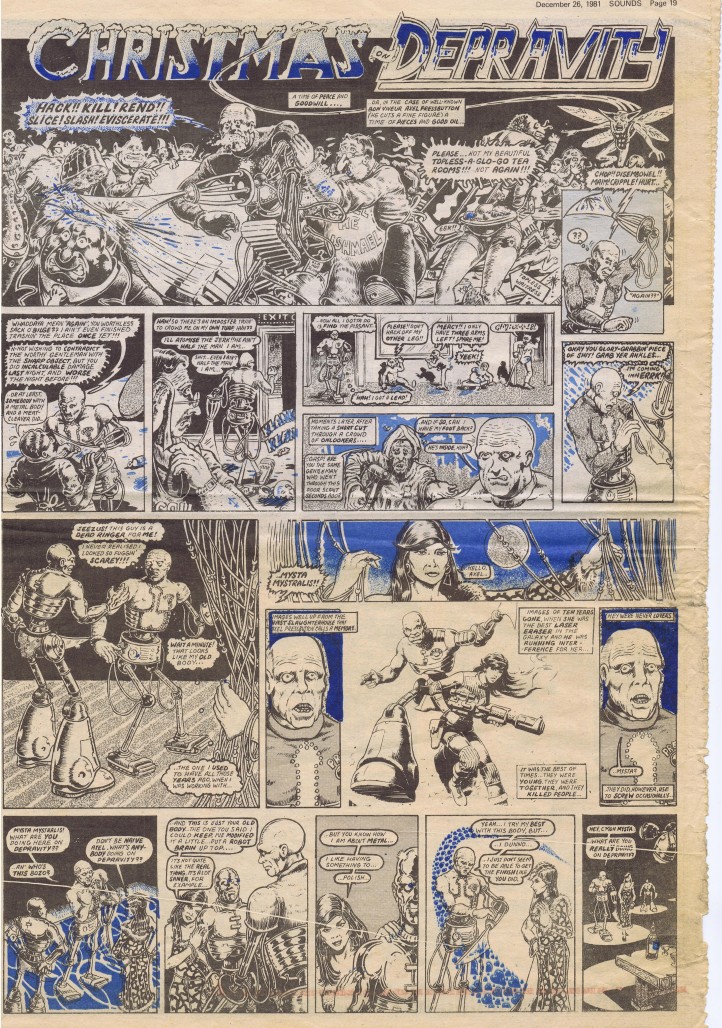 It was a four-page story, and thus the equivalent of eight normal half-page episodes, and it had a second-colour overlay on every page. It was due for delivery on a Monday shortly before Christmas, and Alan turned up at my place on the Friday with about half the strip drawn and none of the colour overlays done; I’m not even sure if he’d actually scripted absolutely everything. So we basically just worked through the weekend on it, with Alan drawing the foregrounds and myself contributing bits of background, often on the colour overlays, where we were just drawing in black ink on tissue-paper overlays. So I was tracing pictures of Japanese monsters, the interior of blood vessels, rains of carrots and anything else I could think of. It was basically work, fall asleep and then work again, but Alan left on the Monday morning to take a finished job into the Sounds office, and I went back to bed. The only trouble was, we’d been told that the overlay would be red on the first and fourth page and blue on the second and third, so we designed the overlays with those colours in mind. Of course, it came out with the colours reversed and, worse than that, the tissue-overlays had actually shrunk under the hot lamps in the scanning process, so everything was out of register, too! We were not amazingly happy about this. But those are the sort of things where you look back and think ‘did we actually do that?’
It was a four-page story, and thus the equivalent of eight normal half-page episodes, and it had a second-colour overlay on every page. It was due for delivery on a Monday shortly before Christmas, and Alan turned up at my place on the Friday with about half the strip drawn and none of the colour overlays done; I’m not even sure if he’d actually scripted absolutely everything. So we basically just worked through the weekend on it, with Alan drawing the foregrounds and myself contributing bits of background, often on the colour overlays, where we were just drawing in black ink on tissue-paper overlays. So I was tracing pictures of Japanese monsters, the interior of blood vessels, rains of carrots and anything else I could think of. It was basically work, fall asleep and then work again, but Alan left on the Monday morning to take a finished job into the Sounds office, and I went back to bed. The only trouble was, we’d been told that the overlay would be red on the first and fourth page and blue on the second and third, so we designed the overlays with those colours in mind. Of course, it came out with the colours reversed and, worse than that, the tissue-overlays had actually shrunk under the hot lamps in the scanning process, so everything was out of register, too! We were not amazingly happy about this. But those are the sort of things where you look back and think ‘did we actually do that?’
->PÓM: You did at one stage interview yourself in the guise of Pedro Henry, for Warrior. How did that come about?
 SM: Dez wanted to do a series of text fe
SM: Dez wanted to do a series of text fe
Blog: An Awfully Big Blog Adventure (Login to Add to MyJacketFlap)
JacketFlap tags: Neil Gaiman, George Orwell, comics, Grant Morrison, Judge Dredd, 2000AD, Alan Moore, Warren Ellis, Pat Mills, David Thorpe, Paul Gravett, Leo Baxendale, Add a tag
The founding fathers would turn in their graves. The British Library is hosting an exhibition of publications in a medium once accused of undermining literacy, decency and the very establishment itself: comics.
I haven’t yet visited Comics Unmasked: Art and Anarchy in the UK, which has been curated by Paul Gravett, author of Comic Art, which I reviewed last month, but I have a shrewd idea of much of its contents because of my own involvement in the industry from the 1980s and ‘90s.
 |
| Deadline 3 - which published Jamie Hewlett's Tank Girl |
British comics and their creators have an anarchic spirit. In the late nineteenth century the 'Penny Dreadfuls' were sometimes considered so subversive and dangerous to the Establishment (in fomenting an industrial dispute) that at one point printing presses used for printing them were destroyed by the authorities, as documented in Martin Barker’s book Comics: Ideology, Power and the Critics.
There is a direct line from these through Fleetway’s Action comic to 2000AD, which in the late ‘70s and ‘80s saw the work of Pat Mills and John Wagner produce strips such as Nemesis the Warlock, which satirised corrupt organised religion, and Judge Dredd, which satirised just about everything including a corrupt totalitarian state (although sometimes Dredd seemed as though it was applauding the very summary dispensation of justice which it avowedly condemned).
Action was created in 1975 by Pat Mills for publishing house IPC. Soon banned for its violent content it nevertheless spawned 2000AD, the home of Judge Dredd.
 |
| Jamie's Tank Girl - whom he called a female Judge Dredd with bigger guns on speed. |
These class-ridden, patriotic comics were produced by the ultra-conservative family-owned Scottish DC Thompson publishers, for much of the twentieth century - up until the days of punk rock as staple fare for boys, a deliberate antidote to the previous, anarchic Penny Dreadfuls. Orwell describes them in depth in the article and observes their propaganda value as follows:
“the stuff is read somewhere between the ages of twelve and eighteen by a very large proportion, perhaps an actual majority, of English boys, including many who will never read anything else except newspapers; and along with it they are absorbing a set of beliefs which would be regarded as hopelessly out of date in the Central Office of the Conservative Party.”
 |
| The cover of Revolver 1, which serialised Grant Morrison's deconstruction of Dan Dare |
Common to both is the preoccupation with slapstick humour, fantasy and science fiction as a way of boggling minds and examining present-day trends taken to extremes.
Orwell himself notes the value of Sci-Fi (which he calls Scientifiction) in this fascinating sentence:
“Whereas the Gem and Magnet derive from Dickens and Kipling, the Wizard, Champion, Modern Boy, etc., owe a great deal to H. G. Wells, who, rather than Jules Verne, is the father of ‘Scientifiction’.”
You can even position later writers, influenced by these earlier names, on this spectrum, such as Alan Moore and Grant Morrison on the left, and Neil Gaiman more in centre-ground. Grant slyly subverted Dan Dare himself , imagining him as an older man sadly looking back on the glory days of space empire in the pages of Revolver in the late ‘80s.
The ‘80s was a key time, because it was then that the kids who had been brought up on the Beano and 2000AD hit adulthood and it became cool to continue reading comics. Inspired by Moore’s Watchmen and V for Vendetta, and the American Frank Miller’s Batman: Dark Knight Returns, younger artists and writers gave birth to an explosion of creativity.
 |
| The cover of Crisis issue 3 - probably the closest ever to Orwell's dream of a left wing comic. |
 |
| Pat Mills' and Carlos Ezquerra's Third World War deliberately made very cool heroes out of disabled, black, gay or female characters. |
Crisis was largely Pat Mills' brainchild. Overtly political and radical it ran the amazing anti-American Imperialism strip Third World War, which attacked CIA involvement in central and south American countries, a topic already tackled in comics by Alan Moore's and Bill Sienkiewicz's documentary graphic novel, Brought to Light.
 |
| The cover of Doc Chaos 1 by me, Lawrence Gray and Phil Elliott published by Escape |
Independent creator-owned comics sprang up all over the place, from my own satirical Doc Chaos, published by Gravett's Escape imprint, to Deadline, from Brett Ewins and Steve Dillon, which came directly from a collision between comics and the new House music club culture, the true star of which was to become Jamie Hewlett's Tank Girl. And most of us know what happened when Hewlett met Blur's Damon Albarn: Gorillaz, the first band in history that was made up of comics characters.
 |
| Peter Stanbury's and Paul Gravett's Escape magazine - beautifully designed, arty and hip. |
I must given a special mention to Don Melia and Lionel Gracey-Whitman for publishing Aargh!, Heartbreak Hotel magazine with the supplement BLAAM! Because the mere fact that this anti-homophobic publication could be a comic was testimony to how far the medium had come since the days of Wizard and Hotspur weekly comics in which homosexuality was a heavily suppressed element. Here is Orwell describing a cover image: “ a nearly naked man of terrific muscular development has just seized a lion by the tail and flung it thirty yards over the wall of an arena”.
 |
| Heartbreak Hotel issue 5 cover by Duncan Fegredo |
 |
| The first comic explicitly for black people, Sphinx |
 |
| Repossession Blues from the pages of Blaam! |
 |
| A cover of chaos magick journal Chaos International which shows the use of comics iconography - the exchange of ideas went both ways. |
Alan only went public on this more recently, but Grant overtly used his research in long-running strips such as the intensely surreal Doom Patrol and subsequently The Invisibles, both for DC.
It is not necessary to believe in any of the gods and forces invoked by magical ritual in chaos magick to utilise its effects. The point for all of us was that Nothing is Forbidden, Everything is Permitted, to use Aleister Crowley’s mantra. Chaos magick provided an almost limitless kit of tools to access the far reaches of the imagination. I learned my tricks from a group that met every week in Greenwich, above Bulldog’s café, from the legendary Charlie Brewster, aka Choronzon 666.
I used this massive wellspring of creativity when writing The Z-Men for Brendan McCarthy. Brendan was a maverick comics artist who started work in 2000AD, later becoming like many comics artists a film storyboarder, who was renowned for his psychedelic, mystical artwork.
All of us were also heavily influenced by Dada and Surrealism – this was the premier topic of my undergraduate degree. It is very obvious in Grant’s Doom Patrol - just read my favourite story The Painting That Ate Paris; and how else could you come up with a superhero who is an entire street (named - of course - Danny)?
 |
| Pure anarcho-comics: Hooligna Press & Pete Mastin's Faction File collected from the pages of squatting magazine Crowbar - back full circle to the aims of the Penny Dreadfuls |
I attribute all of their success not just to their supreme storytelling abilities but to their political views and their involvement in anything occult, arcane and extreme, because in these genres of comics, what readers demand is out-there imagination – and it takes some serious head-space distorting tricks to cultivate a mind that can repeatedly and frequently, on demand, to a punishing production schedule, come up with the mind-boggling concepts, characters and storylines required.
These lessons were not lost on the more recent wave of massively successful British writers, such as Warren Ellis and Brian Hitch, the creators of The Authority, (just read Warren Ellis' Transmetropolitan for a taste of his brand of anarchy).
And I believe there are lessons here for all writers and artists who aim at children and teens, that most demanding of all audiences, to help them feed and stoke the furnaces of creativity and imagination.
I could even attempt to sum them up in the following seven guidelines. Bear in mind that these are methods I am suggesting, and in no way am I advocating tackling a particular kind of subject matter. These are ways of researching, preparing to write and draw, and of writing and drawing itself:
- Feed your mind with stuff from the far reaches of experience; and apply that to the everyday.
- You can’t be too extreme.
- JG Ballard's maxim: follow your obsessions.
- Never censor yourself – leave it to someone else.
- Boggle minds.
- Maximise drama.
- Above all - don’t take it too seriously.
Blog: PW -The Beat (Login to Add to MyJacketFlap)
JacketFlap tags: Movies, Judge Dredd, 2000AD, Tharg, Top News, Dredd, Arthur Wyatt, Henry Flint, Add a tag
Tharg popped round for a biscuit earlier, before thrusting a piece of yellowing paper into my hands and saying “this can run immediately.” It appears that 2000AD are endorsing the 18th September as ‘a day of action’, you see, during which they hope to drum up support for a sequel to the pretty-brill 2012 DREDD movie starring Karl Urban.
Day of Action comes exactly one year after the film came out in cinemas. Despite doing brilliantly in the UK and a growing cult-classic status, the film flopped in the US and plans for a sequel (plans for a trilogy, actually, writer Alex Garland revealed) were put on hold. However, a petition for a sequel has so far raised 80000 signatures, and there’s always a possibility that fan impact voting might help push a sequel through.
2000AD have officially endorsed the campaign for a Dredd sequel, which is where the 18th September comes in. Next Wednesday Judge Dredd Megazine will be publishing part one of their print sequel to the movie, written by Arthur Wyatt and drawn by Henry Flint. 2000AD are obviously hoping that sells well, but they also ask people to sign the petition, buy the movie, and buy shirts in support of the campaign. I imagine other activities will be going on as well.
So, if you want to see a sequel to DREDD, it looks like next Wednesday is the time to lend your support!
Blog: PW -The Beat (Login to Add to MyJacketFlap)
JacketFlap tags: Comics, Previews, Judge Dredd, 2000AD, Top News, 2000 ad, Emma Beeby, Gordon Rennie, Add a tag
In Dredd’s long and illustrious career we’ve seen many a female Judge stepping up to the plate, from Anderson to McGruder, but the iconic British strip has never been written by a woman. Until now.
 2000 AD, a sci-fi anthology that has run continuously since 1977, has enjoyed a reputation for creating fantastic women characters (Halo Jones!) in the various strips that focus on personality first, and gender last. Judge Anderson is perhaps the most well known example, and her portrayal in the 2012 film Dredd by Olivia Thirlby cemented that wonderfully by showing her as Dredd’s equal in every respect – including costume. In fact that very under-appreciated film is one of the strongest comic book movies of all time in terms of gender politics, carried out in a very “no big deal” manner.
2000 AD, a sci-fi anthology that has run continuously since 1977, has enjoyed a reputation for creating fantastic women characters (Halo Jones!) in the various strips that focus on personality first, and gender last. Judge Anderson is perhaps the most well known example, and her portrayal in the 2012 film Dredd by Olivia Thirlby cemented that wonderfully by showing her as Dredd’s equal in every respect – including costume. In fact that very under-appreciated film is one of the strongest comic book movies of all time in terms of gender politics, carried out in a very “no big deal” manner.
It’s little wonder then that women make up a significant sector of the 2000 AD readership, and yet despite both the wealth of women characters in the book, and the number of women creators in the UK, it’s also long held a reputation as being a boys club when it comes to writers and artists.
You can imagine my delight then in our roundtable review of Prog 1824 last month when I saw Emma Beeby’s name attached to a new strip, Survival Geeks. I first came across Beeby a couple of years ago at Glasgow Comic Con, and she is perhaps best known for her Doctor Who audio stories along with her co-writer both there and at 2000 AD, Gordon Rennie. Rennie of course has been writing great stories at 2000 AD for years, and is thrilled to be working with Beeby.
Not only is this the first time Judge Dredd has been written by a woman, but Suicide Watch also sees the introduction of the strips first ever Muslim Mega-City One Judge, Judge Hamida. It’s really refreshing to see a publisher stepping up to the plate in terms of diversity both on the page and behind it, and with a world of solid and well-rendered characters at 2000 AD, I hope it leads to the progs being read by an even wider audience.
As with all Judge Dredd strips, Suicide Watch is completely readable to newcomers while containing elements of previous storylines. The city is decimated since the Day of Chaos events with 87% of the population wiped out, and Suicide Watch looks at the psychological damage to the survivors as suicide cults become ever more popular in the desperate slums.
Something worse though is hunting in the shadows, something that Dredd can’t quite remember… Psi-Judge Hamida is on the case!
Suicide Watch will be told in three episodes, with the first appearing in Prog 1826 this very week.
Judge Dredd: Suicide Watch (Prog 1826-1828)
Writer: Gordon Rennie, Emma Beeby
Artist: Paul Davidson
Colourist: Chris Blythe
Letters: Annie Parkhouse
Editor: Tharg the Mighty, Matt Smith
Publisher: 2000 AD
Blog: PW -The Beat (Login to Add to MyJacketFlap)
JacketFlap tags: ian edginton, d'israeli, Reviews, Comics, Judge Dredd, 2000AD, Top News, Add a tag
2000AD, the British anthology comic, announced that their most recent issue – last Wednesday’s prog 2814 – would be an easy jump-on point for anybody. Anyone can pick it up and get an idea of what 2000AD is all about, what the writing style is like, and how the stories work.
So, that came across like a bit of a challenge really.
With only an inch of haste, we gathered many of The Beat’s reviewers into Pentangle Formation and promptly all jumped on. Some of us have been reading 2000AD for years, some have jumped in and out – I myself only have a recent knowledge of it, having started sporadically picking up issues last year. The idea was that we could all jump on – so with that in mind, what did we all jump on to?
Hannah Means-Shannon: New to 2000AD
I’ve never read 2000AD proper before, though I have a couple collections that intrigued me, and many friends who have rooms full of progs. It’s an embarrassment of riches that does make it hard to find a jumping on point, and so, in my case, I kept putting it off. I’m happy with the contents page of Prog 1824 and I think it creates a sense of orientation for the reader. We’ve got Tharg announcing that he’s the editor, and also running through the included story titles and author/artist credits. Then the contents column breaks the stories down a little by providing the classic recap on characters and the original creators of those tales. I noticed that each synopsis there actually gives the time and location setting for the stories, too, all very helpful.
JUDGE DREDD: “Cypher” wasn’t my first experience of Dredd since I’ve been reading the newish IDW series, but would do well to give the reader a sense of who Dredd is in a general sense, as well as the chaotic world that he moves in. The artwork is strong and as well as packing in plenty of dynamic action, we get some apocalyptic long-shots to build atmosphere. I also found the colors very appealing, sharp and rich.
DANDRIDGE: “The Copper Conspiracy” didn’t talk down to the newbie reader, but jumped right into the premises of its universe while dropping instructional detail about Dandridge’s role a as a ghost, the focus on magical objects, and the globe-trotting potential of the storyline. I particularly liked the over-the-top characterization of Dandridge, making him recognizable in any story context.
THARG’S 3RILLERS: “Survival Geeks” sold me on the artwork, but didn’t appeal to me right away, almost certainly because it deals in so many Geek stereotypes. It traced a fine line between funny and predictable, until the entire household of Geeks was introduced, then I found it a little more appealing. I liked the premise that the world could seem “normal” but be vastly altered in another dimension and the way that reality moved quickly into the narrative.
The real shell-shock admiration I felt for Prog 1824 was STICKLEBACK: “Number of the Beast”. Now I get what people were hinting at about his return. The artwork is mind-blowing. I would buy the prog just for this story (which explains why he’s on the cover too). This narrative by Ian Edginton and D’Israeli displayed a lot of the strengths of the other stories but went further. It loaded on the expository detail, crammed in the intricate detail in the panels, and also suggested continuity with past stories that might lead me back to other progs to find out more. The artwork on the library scene alone made me pause for several minutes. I like the moral ambiguity of the Stickleback character and the as of yet unanswered questions posed.
So, how does it all work as a jumping on point? I was fine: no problems understanding the characters or the stories, but I might have found it a little more of a collision of worlds if I hadn’t read the contents page first. Instead, I found myself asking, “How would long-term readers view this? Too obvious and basic for them?” I don’t think so – there’s enough commitment to quality in the storytelling and the engaging artwork to make it worth their while, too.
Todd Allen: 2000AD Veteran
While it may be a jumping on point, 2000AD took another page from Marvel Now and started out a few stories where I wasn’t entirely sure where they were starting from. (Like not having read Avengers Vs. X-Men was a bit of a stumbling point for several of the relaunches.)
Judge Dredd is dealing with political fallout from a previous storyline. Stickleback is resurrected, but I’m a little fuzzy on who/what he’s supposed to be past some sort of boss crook in a supernaturally influenced world. Dandridge did a little better job of setting it up in an interesting way. Survival Geeks starts from the beginning, though.
I thought Dandridge was the pick of the of litter with a clear, whimsical attitude to the strip. I suspect I’d like Stickleback more after a few more pages, once I get a better feel for what it’s supposed to be. Dredd is Dredd, and his own genre. I like Survival Geeks more than I usually like the Tharg’s 3hrillers/Time Twisters/Future Shock material, but that’s not what I usually look to 2000 AD for.
Interestingly, Judge Dredd was the most serious strip this time out, with a low-satire installment, though Dredd will hit all over the spectrum from story to story.
Henry Barajas: New to 2000AD
The story that sold book for me is Dandridge. I really enjoyed the set up and introduction to the outlandish British super spy. My only complaint is that the story wasn’t long enough. The beginning was long winded and I could care less about the premise, but it wasn’t until the last two pages of the story where I felt engaged. With witty dialogue, Alec Worley told a good joke and Warren Pleece’s smooth panel to panel transitions executed the punch line. Dandridge’s a jolly good time, and made good enough bait to hook me for the next issue.
I could have done without DREDD. This story is so predictable.
THARG’S 3RILLERS focused too much on the cultural references and lacked any kind of depth.
Laura Sneddon: Vintage 2000 AD Fan
As a trade reader, I’m familiar with the Dredd strips of old and some other titles including The Ballad of Halo Jones and Rogue Trooper and so forth. What I hadn’t previously tried was a weekly edition of the prog (save for my treasured collection of Zenith issues!), so the idea of a good jumping on issue was really appealing to me.
The cover caught my immediate attention as I recognised the work of the wonderful D’Israeli (SVK), but resisted diving straight for that story. Despite being a huge Dredd fan, his story didn’t quite grip me as an opening gambit, though the character of Pax does have me intrigued. Dandridge too was not to my style, though I sense it will be popular. Such is the problem with anthology titles, alas.
Survival Geeks on the other hand won me over immediately, with really relatable characters and genuine freshness. Of course I almost always enjoy Gordon Rennie’s work, and it was a thrill to see a story co-written by Emma Beeby. This strip had an almost Doctor Who type vibe and I’m keen to see where it goes!
My clear winner though was the wonderful Stickleback, and I’ve already ordered the tpbs I need to catch up (not necessary to follow the story as presented here, but required for my brain to purr). Utterly beautiful, this has a classy European vibe and a gloriously unsettling dark edge.
Zainab Akhtar: Trade Reader
2000AD have been advertising this issue as a jumping on point for new readers, and as someone who’s never previously read an issue, I would both heartily agree and recommend doing so. My previous sojourns with the prog have all been in trade format: Stickleback, Mazeworld, Cradlegrave, Leviathan to name a few favourites, so I really didn’t know what to expect, but I was very impressed. I’m wary of anthology formats, but happily, it works fine here, with four stories of about 6 pages each. That means not having to divide my attention between too many strips, and the length is enough to keep you engaged and interested whilst giving an ample chunk of story.
What’s more, all four stories work, too. I’m not a Judge Dredd fan, but we get a rather nifty chase scene and that particular world is quickly established for the unfamiliar. It helps that it’s a pretty straightforward opening with no intricacies. Inaki Miranda’s art and Eva de la Cruz’s art and colours provide the strongest art in the book. Dandridge is entertaining enough, but I’m not really feeling the flamboyant supernatural spy formula. Tharg’s 3rillers on the other hand, I loved: it’s a lot of fun, with some nicely drawn dinosaurs and a bit of inter dimensions/time travelling thrown in, which pretty much guarantees my interest.
But let’s be honest: what I was most excited about here was the return of Stickleback (pick up the trade if you can- it’s excellent). I really like that Edginton’s thrown us for a bit of a loop: I was expecting some quickly explained death escape and back to business, but Stickleback the man? thing? has changed, as has the world around him… It may be a little murky to the new reader, but it’s still accessible, I would think.
A final verdict then: very, very impressed with the issue, and it’s one I’ll be picking up in print and following, for the next installment at the least.
Steve Morris: Knows who Judge Dredd is
It’s a good issue to jump on with,although you are jumping into established characters rather than new pitches from 2000AD. The Dredd strip here is technically exploring the fallout of a previous storyline, for example, and the ramifications it had on Dredd’s world. Out of the four stories, three of them require a little explanation for new readers. The creative teams all handle this easily, though, with Dandridge especially well set up – keeping the main character absent until the end means he can be extravagantly hyped before new readers actually gets to see him, but also acts as a great joke for fans already aware of the character. With each strip only moving five/six pages at a time, Dandridge does a rather fantastic job of using those pages well.
Dredd is a little less efficient, starting off with what seemed like a promising storyline which is promptly interrupted by an action sequence. When firing on all fronts, Dredd is usually able to mix storytelling, satire and action together into a big pulpy stew – here we get an action sequence, which is fun if not a little simple.
Similarly, the first part of Survival Geeks struggled a little with the satire and humour. While the story itself is fun enough, the characters all seem to have wandered in off the set of The Big Bang Theory, with the strip prizing the idea that comic/sci-fi fans can’t function in normal conversation with normal people. The art was really nice though, and I did enjoy some of the one-liners.
Stickleback was perhaps my favourite of the strips, though, nipping a old-fashioned tone with startling artwork and a main character who walks and talks like a Noel Fielding creation. It’s silly and well staged, and I enjoyed it a lot. I’m already onboard for 2000AD, but this issue struck me as a fairly decent launching point for new readers to come on in and try things out.
The Beat Herself
John Constantine doesn’t have quadriceps.
Blog: PW -The Beat (Login to Add to MyJacketFlap)
JacketFlap tags: Mike Molcher, Interviews, Comics, Retailing & Marketing, HYPE!, Movie Comics, Judge Dredd, 2000AD, Comics Media, Alan Moore, Top News, Add a tag
Mike Molcher is the PR Co-ordinator for Rebellion, meaning he is the man directly responsible for promoting their comics, 2000AD and Judge Dredd Megazine. If you’ve noticed over the last few months that more people are talking about 2000AD, be it the recent ‘Trifecta’ storyline, or the ‘gay Judge Dredd’ teaser which got picked up everywhere – that’s Mike Molcher’s work. He’s also an interviewer and writer himself, who has interviewed many of the key figures who have worked at 2000AD over the years, including Alan Moore, Warren Ellis, Dave Gibbons and Carlos Ezquerra.
But how do you go about promoting a company like 2000AD, which releases a new anthology EVERY WEEK? I spoke to Mike about his work with the company, to see how exactly he goes about promoting the series. And what is comic book marketing, anyway? How does it work? Is this interview secretly all part of his marketing plan?
By reading this, have we become trapped in Mike Molcher’s sinister plans for 2000AD to take over the world? Oh dear…
Steve: I’ll start with a self-sabotaging question: since 2005 you’ve been involved with interviewing some of the most influential 2000 AD creators – from Alan Moore to Carlos Ezquerra. What makes for a good interview?
Mike: Oof, tough start! I can’t say mine are particular exemplars of good practice so I can only speak about the interviews I enjoy reading – they tend to be the ones that actually stray away from what’s on the comic book page to what’s going on in the mind of the creator, what motivates them, what inspires them, what grinds their gears. By uncovering these things the interviewer can begin to form a picture of the roots of that person’s creativity. Talent and ability never exist in isolation, they have always come from somewhere (usually thanks to a lot of hard work) and it’s the people of comics that I find most fascinating. I like to think my interviews try and achieve that (he said, nervously).
Steve: Before you took on your current role, you worked as a features writer for 2000 AD. How did you first come to get involved with the company in this respect?
Mike: I think it was Matt Badham who first mentioned to me that 2000 AD was looking for creator interviews and features. At the time I was a local newspaper reporter in the north of England but had started up my own self-published magazine, The End is Nigh, which took a Fortean Times-style look at end-of-the-world theories. I’d interviewed Alan Moore about the apocalyptic aspects of his work and his ideas on the approaching human singularity, so I did a retrospective on him for the Judge Dredd Megazine. That opened the door to interviews and I’ve been doing them ever since. Fortunately it meant that when I applied for the job they already knew me and knew that I was a big 2000 AD fan.
Steve: Obviously, your goal as a features writer is to promote and flesh out the company you’re writing for at the time. Do you think there’s a natural step between journalism and PR? How do you alternate between the two?
Mike: I don’t know what it’s like in the States, but you’ll find many of the big names in PR in Britain started out as journalists in some respect. Personally, I’d say that firsthand experience of what goes on inside the head of a journalist and what makes a good story is invaluable when you’re trying to reach out to reporters and reviewers. I continue to write creator interviews in my spare time for the Judge Dredd Megazine and Comic Heroes, so personally I think one compliments the other, because it keeps me abreast of what’s going on in the industry and how we can use that to our advantage at work.
Steve: Only a short while ago you moved to become Rebellion’s PR Co-ordinator. What sort of work does this involve on a day-to-day basis?
Mike: Answering a LOT of emails, mostly. 2000 AD represents just part of my work so I spend a lot of time writing press releases for new titles and announcements, keeping the social media side of things flowing, running blog tours for our three novel imprints, keeping track of the development of the various games Rebellion are working on, plus trying to work out new opportunities to promote our products. Fortunately we’ve recently taken on a marketing coordinator, Robbie Cooke, whose focus is more on the games side of things so he’s been a massive help with that.
Steve: Rebellion don’t just publish 2000 AD/Judge Dredd, but also handle novels and computer games. How do you structure your time between the three?
Mike: With a rather heavily annotated diary, a lot of scheduling, and an increasingly wrinkled brow. Working across three different industries can be pretty mad at times and making sure I give equal time to every new title and product can be damn hard work. Ultimately I have to judge whether something needs a slight PR nudge to sell or a heavy marketing shove out the door…
Steve: The Dredd movie came out last year, giving you a unique opportunity for promotion on a wider field. How did the movie affect the way you promoted the comics?
Mike: I very quickly learned that ANY mention of movies gets people really excited – our most shared image on Facebook was one I did publicizing the fact that DREDD was number one in the DVD and Blu-Ray charts over here and even the slightest mention of the movie would get a huge response. We’re constantly asked whether there are movies coming for our other characters, so it seems the magic of film hasn’t exactly diminished in the digital age!
We obviously went heavy on the promotion of Judge Dredd to tie in to the movie and that’s really paid off – the collected ‘Case Files’ have been flying off the shelves on both sides of the Atlantic – but I have tried to make sure that when someone discovers 2000 AD for the first time they quickly see that it’s not all about Dredd, as loveable as he is. We have a huge and constantly growing back catalogue of some of the greatest characters in comics, from Halo Jones to Nemesis the Warlock and more recent things like Shakara, Low Life and Brass Sun.
Steve: Were there any promotional campaigns you were surprised to see get less attention than others? Do you find, when promoting a comic to a film audience, there was a difference in reaction than when you promote more directly to comic fans?
Mike: Nikolai Dante ended last year after 14 years. And when I say ended, writer Robbie Morrison and artist Simon Fraser brought the Russian rogue’s story to a close. In effect, we killed off one of our most popular characters. And he ain’t coming back. For a comic book to do something as bold as that, I thought, deserved more attention – alas, no-one really picked up on the announcement. It may be that he never had the right profile outside of 2000 AD, but by the time I came on board it was a bit late to change the situation.
I don’t think there’s a big difference in the way you talk to the two audiences other than reminding yourself that the film audience won’t be as conversant in the language and culture of comics as someone who’s been reading them for years. The biggest question we got was “I loved the movie, where do I start reading?”. We were very fortunate that someone can see DREDD then walk into their local comic book and walk out with a comic featuring the same character they saw on screen; Karl Urban and Alex Garland nailed the character of Judge Dredd so perfectly that it was like he’d leapt off the page. So marketing to fans of the film was a case of giving them a good starting point (The Complete Case Files #4, if you’re interested, then #5 and then pick up a copy of ‘Origins’ and ‘America’) and then letting them discover it for themselves.
Steve: You’ve spearheaded several successful campaigns for 2000 AD over the last year – the ‘gay Judge Dredd’ promo picked up a lot of attention, in particular. How do you decide which comics might be suitable for a push, and which stories are going to pick up the most attention?
Mike: I talk to 2000 AD’s editor Matt Smith about what we have coming up and he’s very good at highlighting things that are noteworthy. For example, we recently had BPRD’s James Harren do his first Judge Dredd story and we’ve got a couple of big artist announcements coming in the next few months which are quite exciting. I always do a baseline social media push for each edition of 2000 AD – teasing new stories or returning series, promoting striking covers – but quite often there’s something specific to push like new or returning talent.
The ‘gay Dredd’ campaign was a particular highlight. Not every fan was pleased with my tactics there, but the wall by my desk covered in national and international media clippings and the 30% hike in sales for that particular issue (with high retention and new subscriber rates) makes me feel somewhat justified. It was the same for the return of the Dark Judges as part of the Judge Dredd: Day of Chaos storyline – we ran a great teaser campaign with CBR and the sales graphs all blipped upwards and stayed there.
Alongside the digital explosion our print edition is benefiting from the higher profile – over the past six months, the 2000 AD iPad app has not only grown our number of subscribers overall but has also bolstered the number of print subscribers. We’ve got clear data showing that promotion has played a major part in that, so I’ve been very pleased with our work over the past year.
Steve: Similarly, the Trifecta story from Al Ewing, Si Spurrier and Rob Williams got a lot of critical acclaim. Can you plan for that sort of buzz ahead of a story being released? Ahead of the issue being released, do you try to arrange for more people to get hold of review copies? How do you manage a story which you think is going to be critically acclaimed, by fans and by reviewers?
Mike: We decided very early on with Trifecta that we wouldn’t spoil the surprise, but that once it was out in the open it was all hands to the pumps – Al, Si, and Rob played along brilliantly and once it was out there we really pushed hard on the reaction from readers and from those reviewers who picked up on what was happening. The issues of Trifecta have been some of our biggest digital sellers as people hear the hype then go back and pick up the relevant issues.
Building word of mouth isn’t much use when it’s for a single weekly issue because by the time people have heard about it it’s already time for the next issue, but when you have an exciting ongoing storyline then you can really help spread the word. We do weekly press previews to bloggers and journalists; getting those all-important reviews means getting copies in the right people’s hands, something that I think we’re much better at doing now than we ever have been.
Steve: Are there any techniques which always help drive attention to a comic? Valiant’s successful relaunch, for example, seemed to have a lot to do with the way they publicised themselves ahead of the first comic release.
Mike: On a very basic level you can’t go wrong with new artwork, the return of popular characters, and intriguing teasers. Nothing’s better for getting social media buzz going than a juicy piece of art or a surprise announcement that your favourite character is coming back. The biggest attention-grabbers are when you change the game a little bit or find a niche no-one knew was there.
Steve: What do you think about the current state of American comics, in terms of marketing? Marvel and DC seem to have become a lot more ‘stunt’ orientated over the last few months. Every other day sees about fifty teaser images get released.
Mike: In an insanely competitive marketplace, it’s small wonder that the big two have to shout louder and louder about their books. I like what DC is doing with its ‘DC family’ blog and the campaigns on titles such as Journey into Mystery, Young Avengers and Spider-Man that Marvel has been running have been spot on (and I was blown away by the skill of their digital announcements at SXSW recently), while Image has completely reinvented itself over the last two years into something a lot closer to the feel and ethos of 2000 AD than I think any of us realise!
I often get asked why we promote 2000 AD the way that we do and why we don’t just let “word of mouth” do our work for us. 2000 AD has been on a hell of a run for the past decade and the word of mouth was very positive, yet we weren’t significantly building our readership. Two years of strong marketing and new distribution and we’re adding readers. It’s not rocket science.
Steve: 2000AD must be an interesting magazine to work on, because it’s a weekly anthology series. How do you focus your PR for each issue? Do you focus on creators, or characters – or the magazine as a whole, single product?
Mike: All of the above! And yes, it’s a constantly fascinating, evolving comic to work on. We have a brilliant stable of artists and writers who’ve really knocked it out of the park over the last 18 months, plus a tiny editorial team who are just as enthusiastic and passionate about 2000 AD as any reader. It can be challenging at times because many non-readers have an idea of it that’s 20 years out of date; all those great strips and creators are fantastic and amazing, but the past ten years of 2000 AD have been universally praised amongst fans as a second golden age and that’s pretty bloody exciting.
Steve: We’ve seen 2000AD building up a reputation overseas (which in this case means America) over the last year or so. How do you approach publicising the magazine abroad? Again, do you find you have to tailor the material you offer overseas readers?
Mike: It’s been a particular aim of mine to make us as much of a part of the comics mainstream in America as any other publisher and I believe we’re starting to get some traction there. I’d like to offer more previews of material to news sites, though it can be a struggle to make people understand that carrying 2000 AD news can bring in readers. We have a great relationship with sites like CBR and Comics Alliance, and some real advocates of our comics in people like Doug Wolk, Karl Keily, and Tucker Stone. We bring out one or two collections specifically for North America every month so it’s a case of publicising them as normal while bearing in mind that American and Canadian audiences may not be as au fait with the language and culture of British comics.
Steve: Do you think digital has evened the playing field a little, now everybody has access to comics from home?
Mike: Completely. For reasons unfortunately beyond our control many comic book readers in North America can’t get hold of 2000 AD as easily as we would like, so being able to beam each ‘Prog’ directly into their hands is a massive bonus. We have a reputation as a British comics powerhouse, so we just have to make sure people are intrigued enough to give 2000 AD a go.
Steve: What would you say is the key to working PR in the comics industry, in the current climate?
Mike: Good material to work with, constant attention to social media and a thick skin (I admit mine could be somewhat thicker).
Steve: What would you like to see more of from comic companies in 2013, in terms of PR, co-ordination, and marketing?
Mike: A bit more innovation, but then that’s easy for me to say and very hard to suggest ways in which you could do it. While marketing is important, it should never drive creative choices but I would like to see marketing that pointedly pushes out into other demographics and stresses aspects of comics beyond the obvious – the industry has a lot of work to do to convince people it’s not all spandex and T&A for teenage and not-so-teenage boys. But it must always be about working with the creative teams, who are the ones delivering the material in the first place.
Many thanks to Mike for his time. Big interview! Repay him by following him on Twitter. If you’d rather see a Tharg-approved twitter feed, however, then you can follow 2000AD too. And if that still isn’t enough Tharg endorsement, head over to 2000AD online.
Blog: PW -The Beat (Login to Add to MyJacketFlap)
JacketFlap tags: HYPE!, 2000AD, Digital Comics, Top News, Comics, Add a tag
Morning in Britain means more British comics talk! The Beat slowly forces its way into multiculturalism, and isn’t it wonderful? Hopefully eventually we’ll bring in a reporter from Fiji, and really nail this 24/7 news cycle thingy.
2000AD have been on a marketing offensive recently, as you’ll probably have noticed. Following the digital release of Greg Staples’ Judge Death teaser yesterday, the magazine has also been quick to push forward with two more digital teasers. The first announces that issue 1824 will be advertised as a ‘jump on point’ for new readers, with the entire issue made up of new stories and strips, which won’t lock readers out of continuity.
The second of their images takes a friendly shot at Marvel’s recent announcement that they’ll be trying out a weekly digital series in June, featuring Wolverine. The teaser reminds readers that perhaps this isn’t the most radical of moves…
Blog: PW -The Beat (Login to Add to MyJacketFlap)
JacketFlap tags: Judge Dredd, 2000AD, Top News, Greg Staples, John Wagnder, Art, Breaking News, Add a tag
Every so often Tharg gets on the blower and gives me a ring, to tell me about new things coming up at 2000AD, the comics magazine he edits. And today he had something rather exciting to show me – this teaser image from Greg Staples, showing Judge Dredd villain Judge Death…
Judge Death is probably the most famous villain in 2000AD’s history, having first been created by John Wagner and Brian Bolland. 2000AD have previously revealed that Wagner will be returning to the world of Judge Dredd – and Judge Death in particular – this year, and it looks like the time has almost arrived! Quake! Fear!
Blog: PW -The Beat (Login to Add to MyJacketFlap)
JacketFlap tags: Reviews, Comics, Judge Dredd, 2000AD, Strontium Dog, Top News, Add a tag
Last Wednesday’s issue of 2000AD was special not just because I don’t think any serialised comic has ever had an issue one thousand, eight hundred and twenty-one before, but also because it’s the 36th anniversary for the prog. To celebrate, the issue features some Judge Dredd, a little Strontium Dog, and a new Brian Bolland cover what looks like this:
With 2000AD now available digitally, more Yanks are able to read it than before – but if you haven’t had a chance to try it yet, I’ll give you a brief explanation of what it’s about. 2000AD is a weekly anthology magazine, which features roughly 4-5 different stories, all of which are around 5-6 pages long at a time. As such, each story is completed over the course of perhaps a month or two, with the more successful strips – Judge Dredd, mainly – then continuing on for the next story immediately afterwards. It’s focused on sci-fi and action, with an emphasis on futuristic dystopias and things getting blown up.
The Bolland cover is one of only two concessions this issue makes to the 36th anniversary for the magazine, with the issue being business as usual. Judge Dredd is the first story – here telling a prologue story setting up what seems to be the next big storyline starting next week – followed by four other strips all midway through their respective stories.
The second concession is a celebratory letters page (what better way to celebrate?) at the end of the prog, which actually tends to be one of my favourite parts of any given issue. 2000AD is edited by an alien called Tharg, who speaks in neologisms and likes to threaten and celebrate the readers simultaneously. It’s, erm… you get used to it.
Of the stories contained in this issue –
Pat Mills and Patrick Goddard’s ‘Savage’ is currently at part 8 of the ongoing storyline, although it seems quite easy to pick up – future dystopia, resistance fighters trying to hit back at the Government, and so on. The most distinguishing part of this story is actually Goddard’s art, which keeps moving from influence to influence in my eyes, whilst remaining something of his own. At times you can see what appears to be aspects of Brian Bolland and Howard Chaykin, mixed with a bit of John Cassaday too. It’s a thoroughly expressive style, and Mills has caught onto it nicely, setting up some character moments for Goddard to excel at.
Ian Edgington and Simon Davis are the artistic team for Ampney Crucis Investigates. Again, I think I can fill out the basic gist of the story, even though we’re currently at part ten. And again, the art somewhat overshadows the story, with Davis offering a surprisingly vivid colouring of his own work which creates a tripped-out vibe to the story, making it feel dreamlike and almost etherial. This is a big fight scene, and the colouring helps push the reader along despite a few moments where the storytelling itself is a little obtuse and hard to follow along.
More confusing is Edginton’s second story in the issue, The Red Seas, with artist Steve Yeowell. This story is also ten parts into the story – and it makes no attempt to hide that. I was rather locked out of this strip, with a storyline which doesn’t explain the circumstances the characters are in, or differenciate the leads. Yeowell’s art is nice, but doesn’t help the reader follow the story – there’s a moment where a rescuer suddenly appears to help the heroes, but Yeowell puts the character in the background, without any distinctive detail on their face to make them recognisable. There are also a few issues with perspective, as far as I can tell. It’s sketchy, and probably best left to people who have read the previous nine parts.
Strontium Dog closes out the issue, a long-running 2000AD character written by John Wagner and drawn by Carlos Ezquerra. Much like in Ampney Crucis, this is a fight issue, with the main character in the middle of some kind of mutant vs humans war. This is classically Wagner in tone and style, with some fun jokes mixed in with a strong sci-fi lean. Lots of violence and warfare, some stirring speeches, and a very quick read indeed. It’s a fun final strip, although it does fly by very quickly.
And finally, a word on Judge Dredd, who opens the issue. This story serves as a prelude to whatever might be coming up over the next few months, and writer Michael Carroll does a good job in setting up something interesting. The impact of the story is due to a very strong last page, which delivers a really interesting cliffhanger for next week’s issue, but Carroll also manages to evoke the style of Judge Dredd whilst throwing in some of his own jokes and ideas. It’s a nice opening piece, drawn entertainly by Andrew Currie, with colours by Chris Blythe.
Annie Parkhouse and Ellie De Ville have been in charge of lettering 2000AD for a long time now, and they both have an excellent grasp on each story, serving the narrative whilst allowing the art to show off the characters and stories. They’re the unsung heroes of 2000AD, so I just wanted to, y’know, sing about them a bit.
2000AD issue 1821 is business as usual for the prog – an entertaining mix of stories and art styles, with a string of high concept ideas and great gags. It’s also amazing how easily most of the stories allow a reader to jump in fresh, without being too confused by what’s going on. I’ve been jumping on at random points for a few months now, to see what’s going on, and every time I find myself enjoying the majority of the stories, no matter where their narrative is or what I’ve missed out on prior. Really, that seems to be the success of 2000AD – after 1821 issues, it’s still offering something for everyone.
Steve Morris is… trying out one of these things where you self-promote yourself after an article you wrote. I have a webcomic! It’s called Stardark City. It’s lovely and I hope you might want to read it maybe sometime? You can also shout at me on Twitter, @stevewmorris.
Blog: PW -The Beat (Login to Add to MyJacketFlap)
JacketFlap tags: Judge Dredd, 2000AD, SDCC '12, Duane Swierczynski, Nelson Daniel, IDW, Add a tag
By Steve Morris
An SDCC announcement which mainly seems to have been announced on CBR and not as SDCC, IDW have revealed that their much-teased new Judge Dredd series will be written by Duane Swierczynski! Which, perfect casting surely. Art will be provided by Nelson Daniel, and the first issue is out in November.

What will the series be like? Given Swierczynski’s past novels, and his run on Cable, it’ll be rather gritty. In the CBR interview posted now before anybody had a chance to mention it at the con, he says
I’d like IDW’s Dredd to feel like a transgressive sci-fi black comedy police procedural — like ‘Law & Order,’ if, say, Jerry Orbach were a violent inflexible fascist
Swierczynski and Daniel’s series will be set in the past, looking back at some of the Judge’s earliest perp-shooting jollies, with back-ups for each issue drawn by people like Jim Starlin. It will be violent! And angry. And the helmet doesn’t look like it’s coming off anytime soon. No sign of Rob Schneider yet.
Blog: PW -The Beat (Login to Add to MyJacketFlap)
JacketFlap tags: Bongo, Capstone, Hermes Press, Bluewater, Yen Press, Zenescope, Papercutz, Avatar Press, Gemstone, Liquid Comics, Red 5, Th3rd World Studios, Hachette, Oni, DC, Marvel, Dark Horse, Image, Archie, Viz, IDW, Fantagraphics, Drawn & Quarterly, Valiant, Top Shelf, NBM, 2000AD, Boom Studios, Arcana, Aspen, Archaia, D&Q, FCBD, 12 Gauge, Antarctic Press, Add a tag
.
Once again, I collected (almost) all of the Free Comic Book Day offerings, and offer my reviews on what’s good, what’s great, and what should have been better!
Titles are arranged alphabetically by publisher, and the images and summaries come from the offical FCBD website. My comments are in purple.
What did you grab? What did you enjoy?
Kid Friendly Titles
ANTARCTICS ZOMBIE KID
(CA) David Hutchinson
All 6th-grader Bill Stokes wants is to get through middle school unnoticed so he can go on to become a big-time pro video-gamer. Then his mom comes home from her medical research volunteer job with a zombie virus. Now Bill has to deal with skin problems and body chemistry changes that make puberty look like a walk in the park! How’s he supposed to realize his dream when his life has become a festering, rotting, undead nightmare?
MOUSE GUARD LABYRINTH & MORE HC
(C) David Petersen
This Free Comic Book Day, Archaia offers readers the chance to experience history in the making with a FREE, gorgeous, 48-page, 6″ x 9″ full-color original anthology hardcover featuring all-new material! David Petersen returns with an all-new Mouse Guard tale that’s guaranteed to tug at your heartstrings! Lose yourself once again in Jim Henson’s amazing world of Labyrinth, featuring a fantastical story from Eisner Award-nominee Ted Naifeh (Courtney Crumrin) and Cory Godbey (Fraggle Rock). Get a new perspective on Jet Jones in Royden Lepp’s
Blog: PW -The Beat (Login to Add to MyJacketFlap)
JacketFlap tags: Judge Dredd, 2000AD, Mark Millar, ian edginton, d'israeli, pat mills, World Comics, Grant Morrison, Add a tag
It’s 2000AD 35th birthday—which seems kind of young, as its brand is so ubiquitous in UK comics—and they will be releasing a bunch of GNs this year including some Dredd-ful stuff by Grant Morrison, Mark Millar, John Wagner and Pat Mills with art by Brian Bolland, Chris Weston, Steve Dillon and Dave Gibbons. For those who like things a little less Tharg, there’s a new edition of LEVIATHAN, a fine riff on the titanic story by Ian Edginton and D’Isreali.
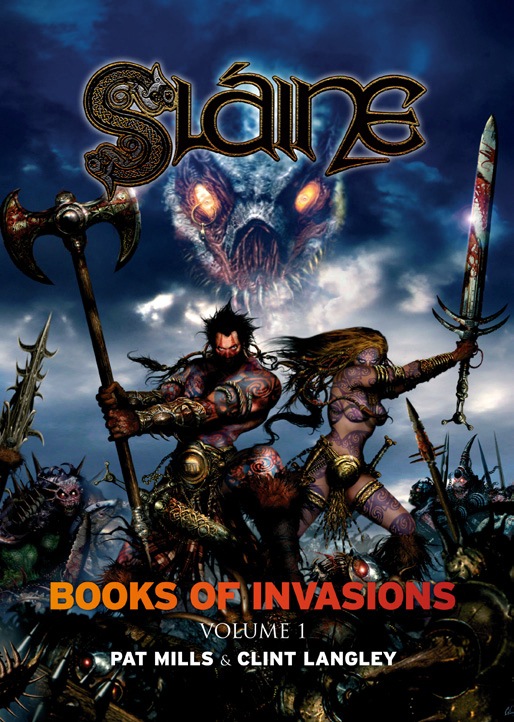
This month, the Celtic barbarian Sláine returns with the first volume in one of the most breathtaking fantasy series ever. Sláine: Book of Invasions 1 (ISBN: 9781907992681 US $19.99/Canada $22.99) sees Pat Mills’ axe-wielding hero begin an epic quest, with 122 pages of visceral work from award-winning artist Clint Langley. Once the first High King of Ireland, Sláine must protect his tribe against a new tide of evil. In the astonishing and fresh follow-up to the critically-acclaimed Sláine: The Horned God, Langley’s full color hyper-real art will blow you away!
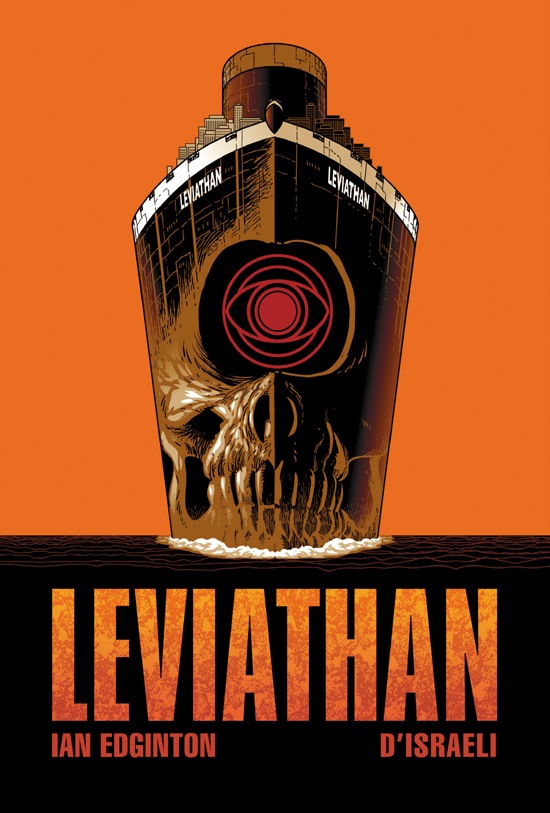
In April, on the 100th anniversary of the sinking of the Titanic, a very different voyage sets sail. Leviathan (ISBN: 9781907992698 US $16.99/Canada $19.99) is a gargantuan steampunk murder mystery from the partnerhsip behind Scarlet Traces – Ian Edington (Victorian Undead) and D’Israeli (SVK). It is 1928 and the world’s largest ocean-liner disappears on its maiden voyage to New York. It drifts for 20 years on a desolate limbo ocean, but when murders begin aboard ship, Detective Sergeant Lament must delve into the ship’s depths to discover the root of its mysteries. This is a stunning story by two massive talents and not to be missed.
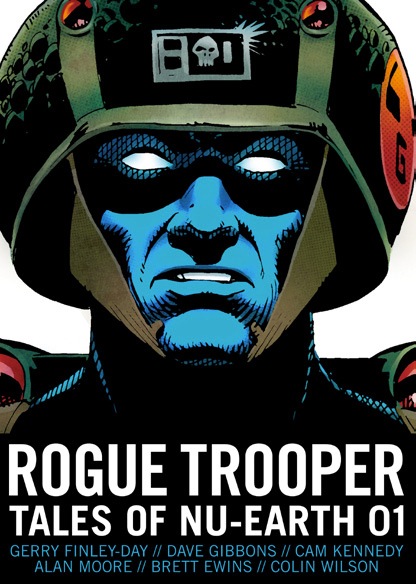
One of the all-time classics in the 2000 AD pantheon, the first US collection of Rogue Trooper lands in May. Rogue Trooper: Tales of Nu Earth 01 (ISBN: 9781907992704 US $19.99/Canada $22.99) features 400 pages of future war action! Created by Gerry Finley-Day and Dave Gibbons (Watchmen), Rogue Trooper roams Nu-Earth, the last of the Genetic Infantrymen. On planet ravaged by war, its atmosphere poisoned by the endless war between the Norts and the Southers, Rogue searches for the general who betrayed his blue-skinned brethren at the Quartz Zone Massacre.
Another classic from Judge Dredd arrives in June. Judge Dredd: Complete Case Files 05 (ISBN: 978-1781080283 US $19.99/Canada $22.99) features three of the all-time greatest Dredd stories ever – Judge Death, Block War and The Apocalypse War! The fifth volume in this hit series, collecting together Dredd’s most exciting cases, features art by such comic legends as Brian Bolland (Batman: The Killing Joke), Carlos Ezquerra and Mike McMahon and written by John Wagner (A History of Violence) and Alan Grant (Lobo)!
Judges have the toughest job on the mean streets of Mega-City One, but they’re only human. So when
Blog: Kev Lev's Blog (Login to Add to MyJacketFlap)
JacketFlap tags: Judge Dredd, 2000AD, Zarjaz, Add a tag
A bit slow on the up-take news-wise, but it looks like a cracking little Dredd strip I finally finished late last year will be out over the summer in Zarjaz issue 15.
Judge Dredd, The Taking of Mopad 456 by Lee Robson and myself.
Some stages for this teaser panel:
part of the bonkers amount of work I did in google sketch-up... in my opinion you can't really tell how much I did used models, for good or bad!
sketched over to add good old Joe Dredd in there. He's celebrating 35 years in comics this week! 2000ad was 35 last week...
here's the inks, see, most of that modelling was a waste of time, or certainly seems to fade into the background.
finally, the toned version ready to have some textures added.
Blog: Kev Lev's Blog (Login to Add to MyJacketFlap)
JacketFlap tags: Nikolai Dante, Comic Book, 2000AD, Add a tag
Yesterday was my turn to submit to the 2000ad virtual advent calendar.
A terrible, terrible pun drifted into my mind - but one that had to be done! Nikolai Dante is the swashbuckling lead character in the 2000ad saga of the same name, created by Robbie Morrison and Simon Fraser. For the uninitiated, Jena Makarov is his love interest (a frequently thwarted one).
here are the pencils and inks for those of you who are interested in the process.

I had a number of captions and dialogue options, some more smutty than others, and I even asked for some opinions, and they were as divided as my own... in the end I left the 'sack' jokes alone, despite the puerile joy of them. You are welcome to suggest any and all alternate options in the comments though!
Blog: Kev Lev's Blog (Login to Add to MyJacketFlap)
JacketFlap tags: 2000AD, Add a tag
For the past couple of years, Pete Wells, charming host of the 2000ad covers uncovered blog has run an online advent calendar on the 2000ad forum.
This year is no different, and once again, my effort is early doors number 2. For those who're interested, and haven't seen them before, here are my efforts for 2009 and 2010.
Not wanting to spoil any potential surprises, here's a crop of my rough.
The final version should be up on the forum already, but if not it will be soon!
You can keep up with the wonderful entries each day until the 24th by calling in to the forum topic here.
Blog: Kev Lev's Blog (Login to Add to MyJacketFlap)
JacketFlap tags: 2000AD, Judge Kev, Add a tag
Jim Campbell should need no introduction, as a letterer at least, but what a lot of people don't know is that he is also a talented artist too.
Jim did the above illustration in response to my Judge Kev photo (see previous post of me in a Planet Replica's Judge's helmet) that was taken by Bolt-01 at Thoughtbubble.
Blog: Kev Lev's Blog (Login to Add to MyJacketFlap)
JacketFlap tags: Sketch, Judge Dredd, 2000AD, Inks, Add a tag
This was quickly sketched out whilst on holiday last week... used it as inking warm-up over the last couple of days.
Blog: Kev Lev's Blog (Login to Add to MyJacketFlap)
JacketFlap tags: Comic Book, Death, 2000AD, Judge Death, Lego 2000AD, Add a tag
Following the 2000ad Lego commission, Ian Leonard asked if I could expand the concept by doing cover recreations of classic 2000ad covers. He had a number in mind, but first up was Brian Bolland's brilliant cover to prog 225.
For ref, I've included the original Bolland version below.
I missed a trick though, I should have edited in a 'Legoland' price... if Ian asks for any more of these, I will add that into the price list somewhere!
Blog: Kev Lev's Blog (Login to Add to MyJacketFlap)
JacketFlap tags: 2000AD, Judge Death, Judge Anderson, Add a tag
Here's something I did for Pete Wells of the 2000ad covers uncovered blog fame.

I'd owed him a sketch for a while, since HiEx 2010 in fact, where for some reason, I only did half a sketch for him.
Blog: Kev Lev's Blog (Login to Add to MyJacketFlap)
JacketFlap tags: Comic Book, 2000AD, Strontium Dog, Johnny Alpha, Add a tag
Here then, as promised in yesterday's post: Johnny Alpha, back in the land of the living.
If you missed it yesterday over on Scotch Corner, here's my Durham red piece mocked up into a prog cover.
And The Johnny Alpha one too.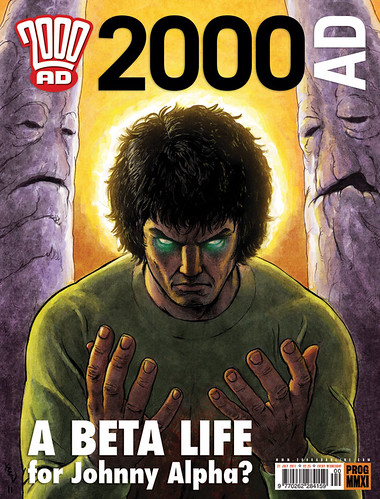
Blog: Kev Lev's Blog (Login to Add to MyJacketFlap)
JacketFlap tags: Sci-Fi, 2000AD, Strontium Dog, Inks, Johnny Alpha, Durham Red, Comic Book, Add a tag
Well, last month I was delighted to be invited to contribute once again to Scotch Corner, the Caledonian Comic Artists Collective who're celebrating their blogging birthday this month with a series of guest slots. I'm am amongst some seriously talented folk contributing, too many cool people to name have already contributed - and there's more to come!
Previously, I've submitted Bat-world pieces to their guest slot: a Harley Quinn, a Joker, and a Catwoman, but no surprises, it is 2000ad that I have turned to on this special occasion. Specifically the world of Strontium Dog, and as is usual for me, I gravitated to the girl in the gang - Durham Red.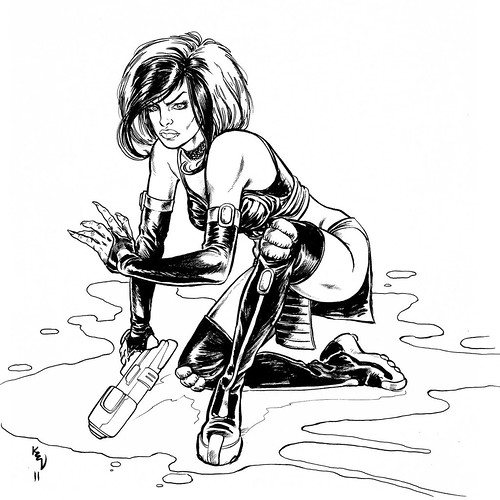
You can see the full coloured version of that over on Scotch Corner. Also note the edited hand... after I'd inked it, and saught the advice of trusted indivduals, I felt this version was too claw like.
If you like this, then please come back tomorrow as I'll be posting up a piece that celebrates the return of Johnny Alpha, in fact, the resurrection of Johnny Alpha and his imminent return to the prog - as trailered in prog 1742, see the prog or ECBT2000ad for the details!
Blog: Kev Lev's Blog (Login to Add to MyJacketFlap)
JacketFlap tags: L Frank Baum, Johnny Alpha, Comic Book, Spoof, Commission, Judge Dredd, 2000AD, Colouring, Scarecrow, Strontium Dog, Judy Garland, Tin Man, Cowardly Lion, Add a tag
Now in Technicolor!
I'm just about done on the Wizard of Oz, Judge Dredd and Johnny Alpha cross-over commission.
There's still a decision to be made over the final dialogue though...
Blog: Kev Lev's Blog (Login to Add to MyJacketFlap)
JacketFlap tags: Judge Dredd, 2000AD, Scarecrow, Strontium Dog, Judy Garland, Tin Man, Cowardly Lion, L Frank Baum, Johnny Alpha, Wizard of Oz, Add a tag
I've been working on a commission for another member of the 2000ad forum.
Ian Leonard asked if he could have a Johnny Alpha and Judge Dredd team-up, where those two bad boys were surrounded by mutants and zombies etc, but also including characters from the Wizard of Oz!
These are the cleaned up inks ready to colour.
The raw scan shows through where I've printed out a 'blue-line' version of my digital 'pencils'.
Here's a few stages of development, including the proposed dialogue on the first.



I feel like Johnny and Dredd should be saying something smart arse too, but inspiration is lacking on that front.
View Next 25 Posts



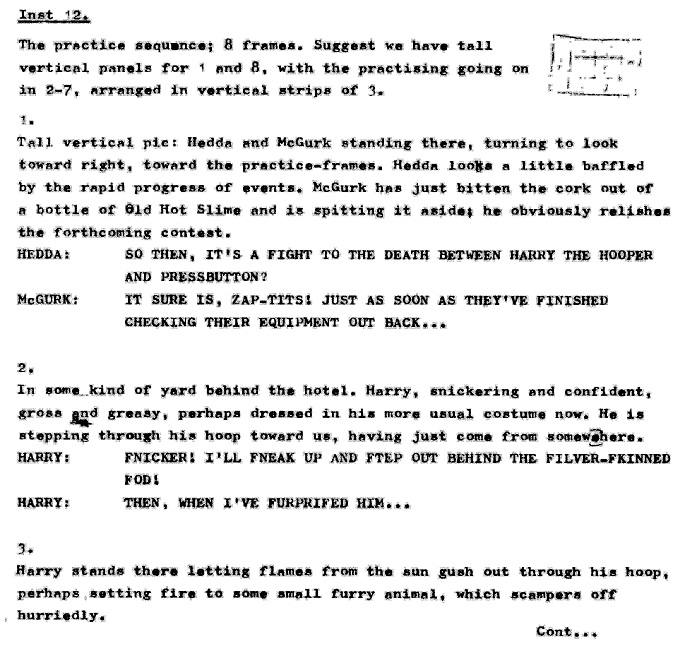





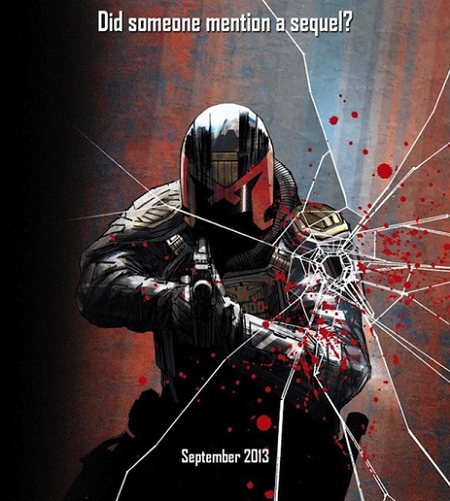

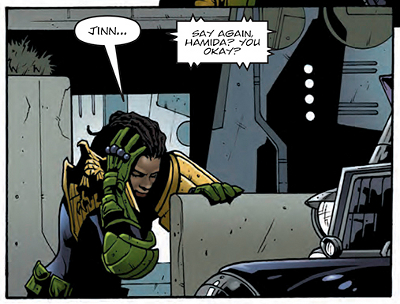


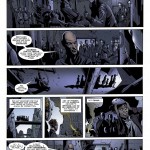
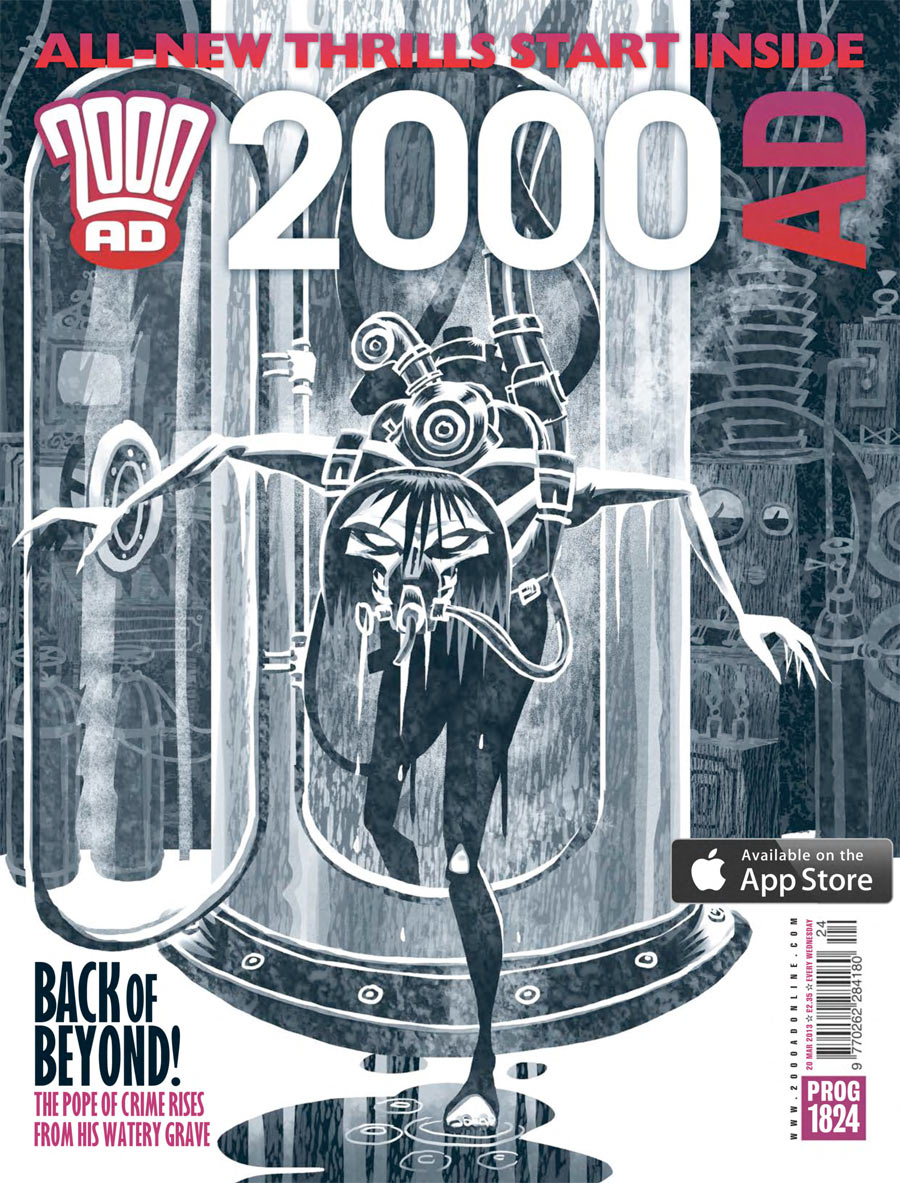

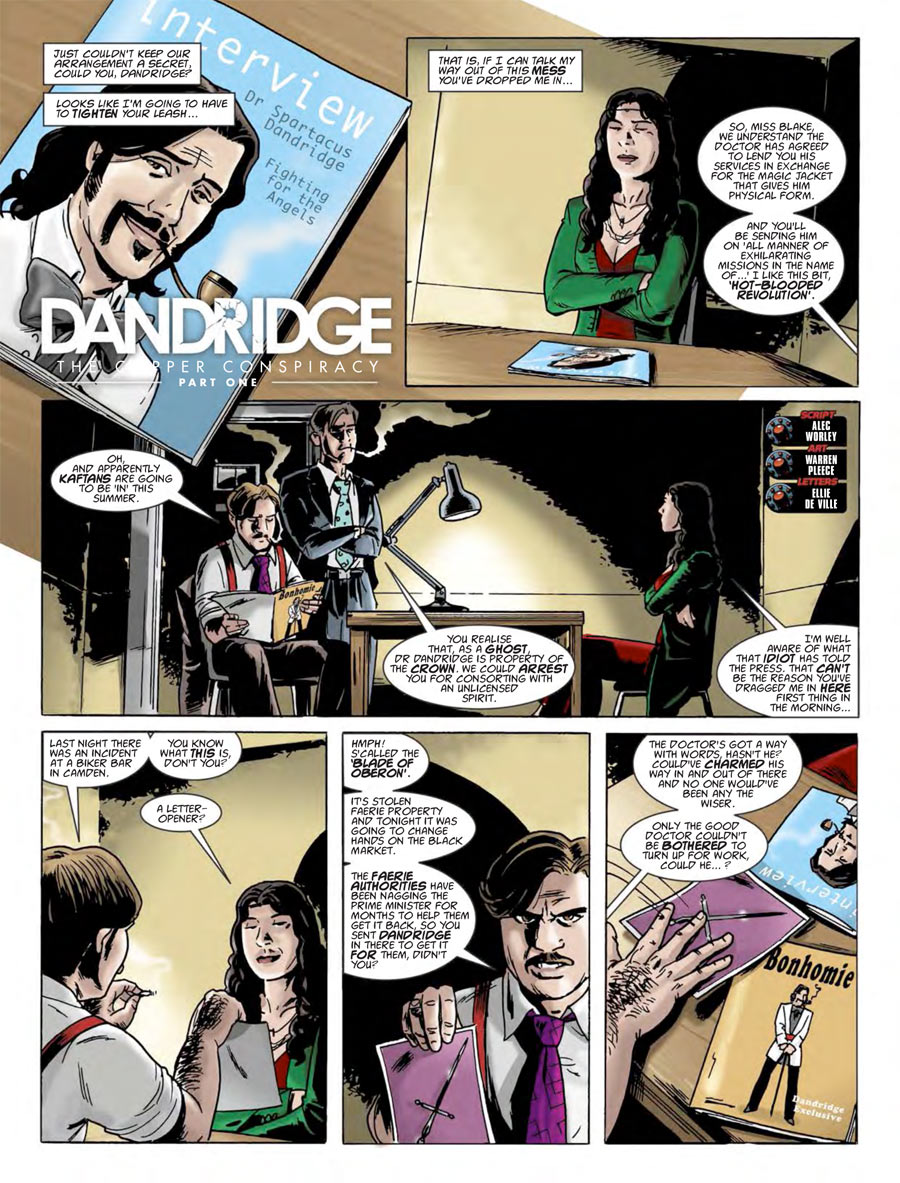
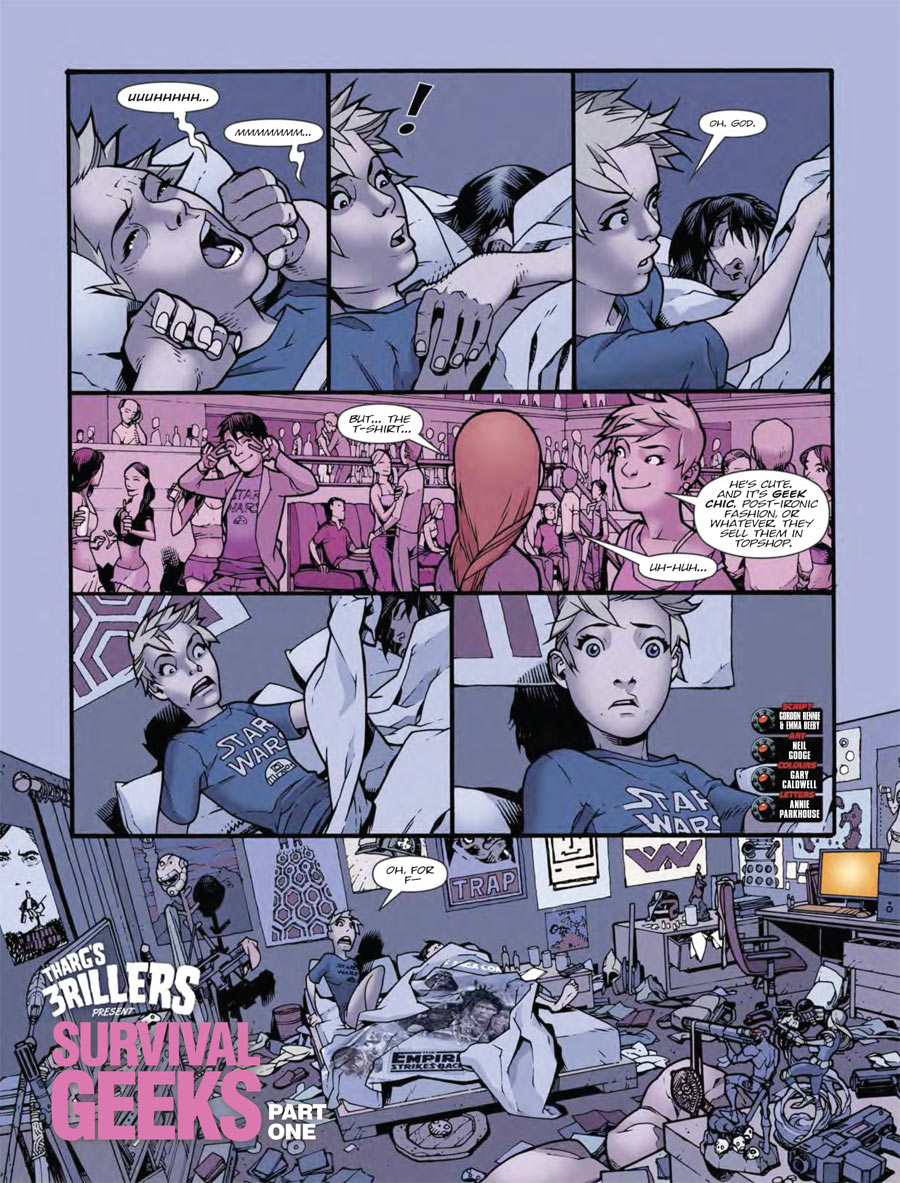

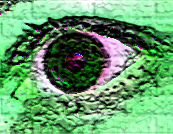


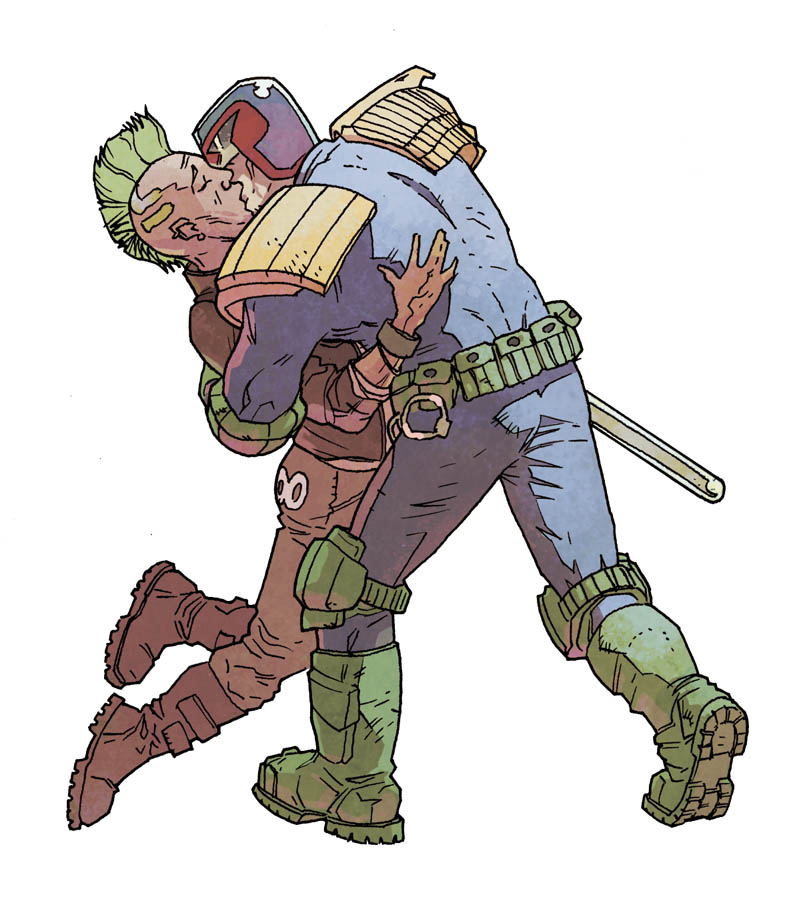

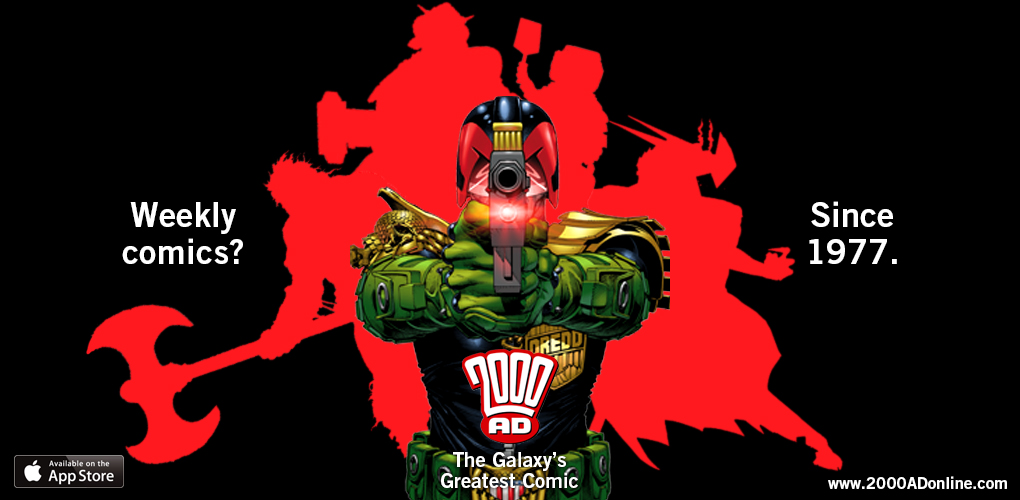

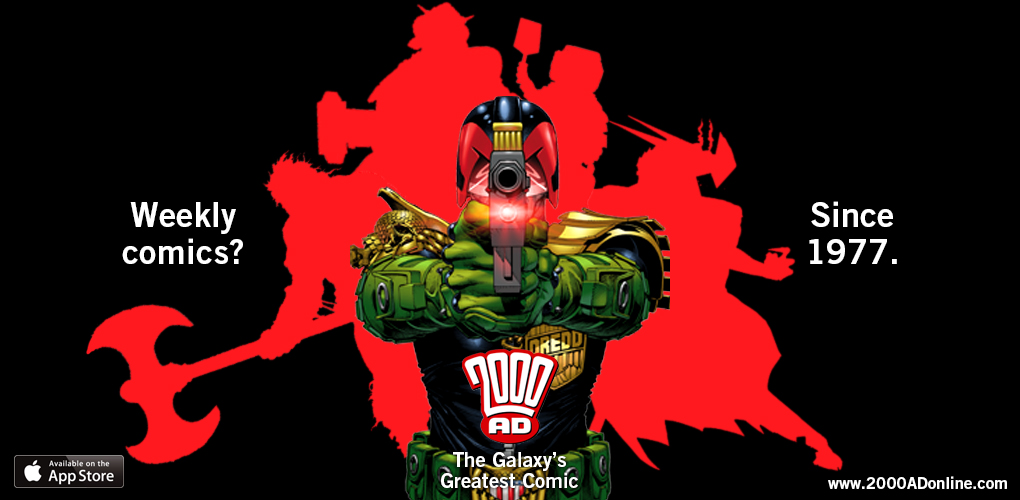

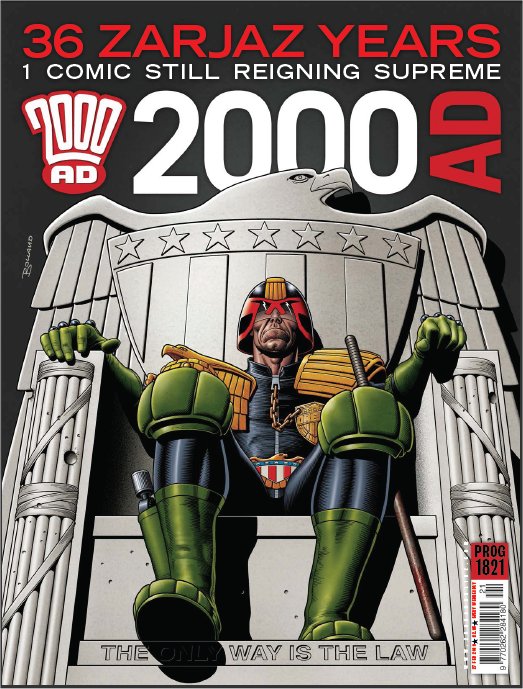
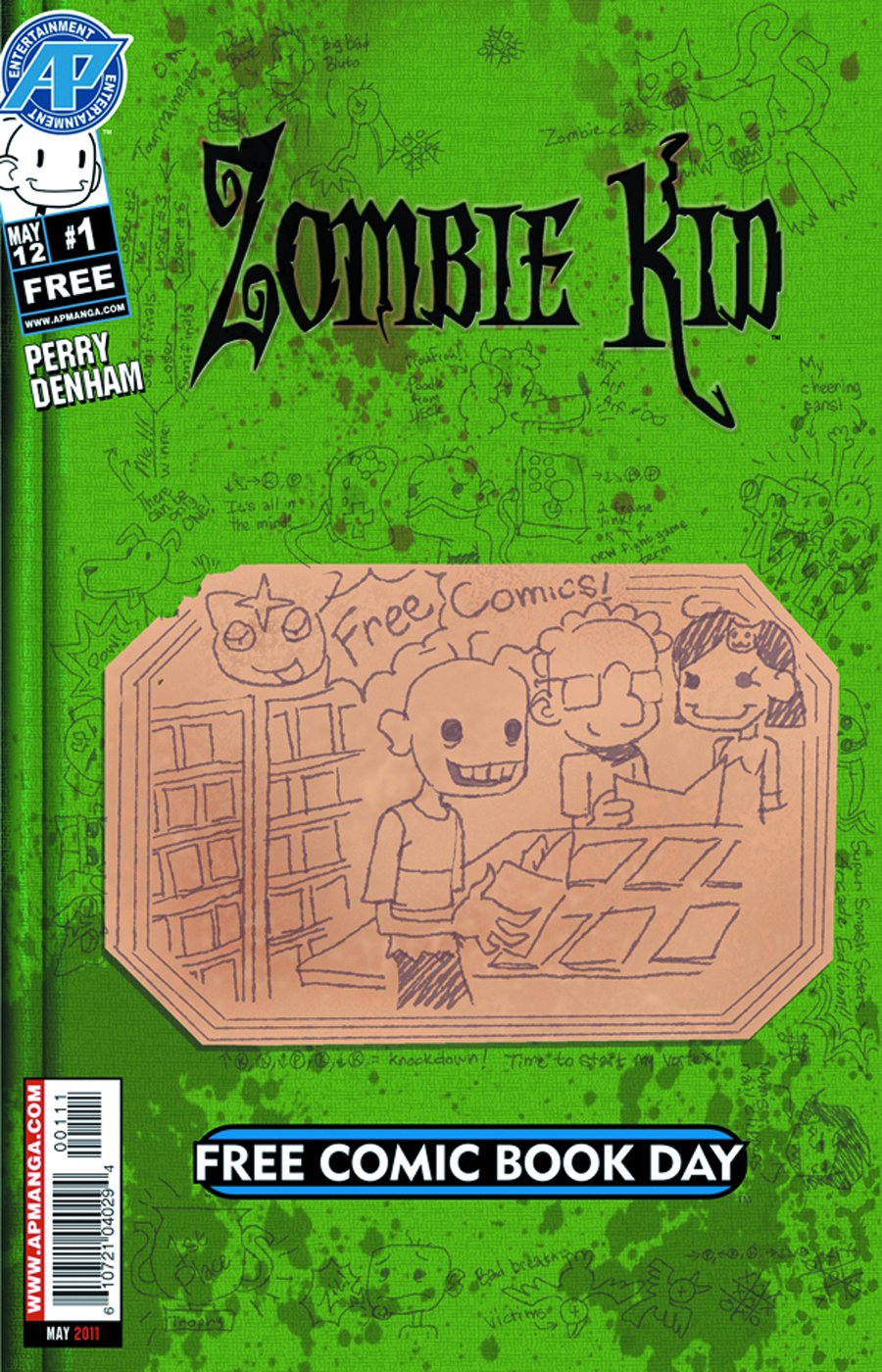

[…] 2000 AD Reprints Monster, an '80s Comics Collaboration by Moore and Wagner Monster, a comic strip published by Scream! from authors Alan Moore (Watchmen) and John Wagner (Judge Dredd) is coming back to store shelves this July. After being out of print since the '80s, the series is coming back via 2000 A.D.. The title is being … Read more on Comics Beat […]